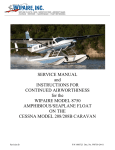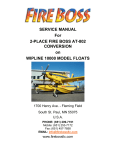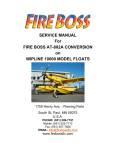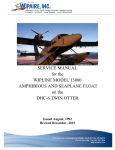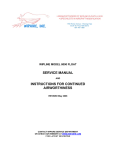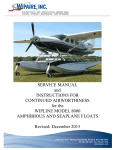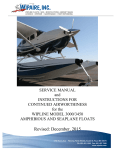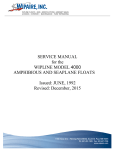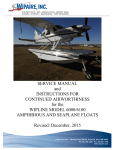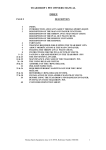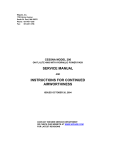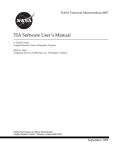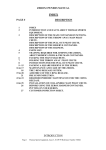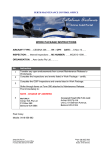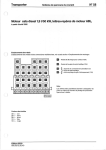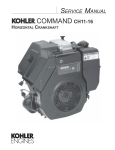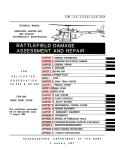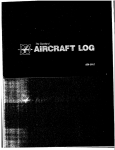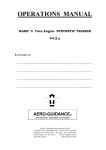Download Model 7000 Service Manual
Transcript
WIPLINE FLOATS • SKIS • MODIFICATIONS • AIRCRAFT SALES AVIONICS • INTERIOR • MAINTENANCE • PAINT REFINISHING SERVICE MANUAL & ICA for the WIPLINE 7000 AMPHIBIAN FLOAT on the QUEST MODEL 100 KODIAK 1700 Henry Ave – Fleming Field (KSGS), South St. Paul, MN 55075 Ph: 651.451.1205 Fax: 651.457.7858 www.wipaire.com SERVICE MANUAL & I.C.A. FOR THE 7000 AMPHIBIOUS FLOATS THIS PAGE INTENTIONALLY LEFT BLANK Revision G Page 2 of 109 P/N 1004646 Doc. No. W7001-24-01 SERVICE MANUAL & I.C.A. FOR THE 7000 AMPHIBIOUS FLOATS LOG OF REVISIONS Revision Pages Description Date A 1 to 98 INITIAL RELEASE B 1 to 100 ECO 22037, See Doc W7001-34-01 C 1 to 100 ECO 22043, See Doc W7001-34-04 D See list ECO 22090, See Doc W7001-34-03 E F G Update to cover page logo, added instructions and G1000 See List Land/floatplane software configuration to float removal and Re-install checklists, added 3 blade propeller maintenance section. See List Added Green Grease as an approved grease Updated Fig 1-6 for new oleo, updated Fig 4-4A, Fig 4-6 and added 4-4B, Changes to MLG See List rigging procedures, remaining paged repaginated, minor changes to float install and removal instructions. 4/18/2013 5/30/2014 H Added shear torque chart, PR 1440 C Sealant and Tef-Gel, removed See List warranty claim form. Corrected 1200 was 1000, 1400 was 1150 and 1900 was 1300. J Added Dow Corning DC4 and Mobil See List Aviation Grease SHC 100 to approved 7/29/2015 product list, update exhaust system Revision J FAA Acceptance 5/26/2015 Page 3 of 109 P/N 1004646 Doc. No. W7001-24-01 SERVICE MANUAL & I.C.A. FOR THE 7000 AMPHIBIOUS FLOATS THIS PAGE INTENTIONALLY LEFT BLANK Revision G Page 4 of 109 P/N 1004646 Doc. No. W7001-24-01 SERVICE MANUAL & I.C.A. FOR THE 7000 AMPHIBIOUS FLOATS LIST OF EFFECTIVE PAGES PAGES REVISION 1-102 D Cover page, 3, 5, 7, 73-106 E 3, 5, 79 REVISION PAGES REVISION F 5, 7, 9, 21, 45110 G 3, 5, 63, 82 H 3, 5, , 22, 82, 90, 96, 107 J Revision J PAGES Page 5 of 109 P/N 1004646 Doc. No. W7001-24-01 SERVICE MANUAL & I.C.A. FOR THE 7000 AMPHIBIOUS FLOATS THIS PAGE INTENTIONALLY LEFT BLANK Revision G Page 6 of 109 P/N 1004646 Doc. No. W7001-24-01 SERVICE MANUAL & I.C.A. FOR THE 7000 AMPHIBIOUS FLOATS TABLE OF CONTENTS SECTION PAGE LOG OF REVISIONS ................................................................................................................................ 3 LIST OF EFFECTIVE PAGES .................................................................................................................. 5 TABLE OF CONTENTS ............................................................................................................................ 7 LIST OF FIGURES AND TABLES......................................................................................................... 10 CHAPTER 1 INTRODUCTION AND GENERAL INFORMATION .................................................... 14 1.0 INTRODUCITON .......................................................................................................................... 14 1.1 GENERAL FLOAT INFORMATION ........................................................................................... 19 1.2 CLEANING .................................................................................................................................... 23 1.3 CORROSION ................................................................................................................................. 24 1.4 FLOAT HANDLING & JACKING ............................................................................................... 26 1.5 MOORING ..................................................................................................................................... 27 CHAPTER 2 AIRWORTHINESS LIMITATIONS ................................................................................. 28 CHAPTER 3 NOSE GEAR ...................................................................................................................... 32 3.0 NOSE GEAR .................................................................................................................................. 32 3.1 ADJUSTMENT/TEST NOSE GEAR ............................................................................................ 34 3.2 NOSE GEAR BASIC SERVICING................................................................................................ 35 3.3 NOSE GEAR DISASSEMBLY ...................................................................................................... 36 3.4 NOSE GEAR ASSEMBLY............................................................................................................. 37 CHAPTER 4 MAIN LANDING GEAR BRAKES & GEAR RETRACTION ....................................... 40 4.0 GENERAL ...................................................................................................................................... 41 4.1 MAIN GEAR RETRACTION DESCRIPTION ............................................................................. 44 4.2 MAIN GEAR ASSEMBLY SETUP AND ADJUSTMENT.......................................................... 51 4.3 ADJUSTING THE GEAR UP POSITION..................................................................................... 56 4.4 ADJUST MAIN GEAR UP AND DOWN POSITION SWITCHES ............................................. 57 4.5 EMERGENCY GEAR OPERATION ............................................................................................ 61 CHAPTER 5 HYDRAULICS ................................................................................................................... 62 5.0 HYDRAULIC SYSTEM BASIC DESCRIPTION ........................................................................ 63 5.1 BLEEDING THE HYDRAULIC SYSTEM .................................................................................. 66 Revision D Page 7 of 109 P/N 1004646 Doc. No. W7001-24-01 SERVICE MANUAL & I.C.A. FOR THE 7000 AMPHIBIOUS FLOATS CHAPTER 6 WATERR RUDDER .......................................................................................................... 68 6.0 BASIC DESCRIPTION .................................................................................................................. 69 CHAPTER 7 ELECTRICAL .................................................................................................................... 72 7.0 ELECTRICAL SYSTEM BASIC DESCRIPTION ....................................................................... 73 CHAPTER 8 HARTZELL 3 BLADE PROPELLER ............................................................................... 76 8.0 HARTZELL 3 BLADE PROPELLER DESCRIPTION AND OPERATION ............................... 77 8.1 MAINENANCE PRACTICES ....................................................................................................... 78 CHAPTER 9 RECOMMENDED PROCESSES, PRODUCTS AND INSP. CHECKLISTS ................. 80 9.0 SERVICING INSTRUCTIONS ..................................................................................................... 81 9.1 CORROSION REMOVAL............................................................................................................. 83 9.2 MAINTENANCE CHECKLIST ............................................................................................................. 84 9.3 FLOAT REMOVAL AND RE-INSTALLATION GUIDE ........................................................... 91 9.4 WIPAIRE FLOATS SPECIAL TOOLS ....................................................................................... 100 CHAPTER 10 TROUBLESHOOTING ................................................................................................. 102 CHAPTER 11 INSTALLATION PRINT INFORMATION .................................................................. 106 APPENDIX A OPTIONAL YAGI ANTENNAS .................................................................................. 108 END ........................................................................................................................................................ 109 Revision D Page 8 of 109 P/N 1004646 Doc. No. W7001-24-01 SERVICE MANUAL & I.C.A. FOR THE 7000 AMPHIBIOUS FLOATS THIS PAGE INTENTIONALLY LEFT BLANK Revision D Page 9 of 109 P/N 1004646 Doc. No. W7001-24-01 SERVICE MANUAL & I.C.A. FOR THE 7000 AMPHIBIOUS FLOATS LIST OF FIGURES AND TABLES FIGURE 1-1: FRONT VIEW.................................................................................................................... 15 FIGURE 1-2: TOP & SIDE VIEWS ......................................................................................................... 16 FIGURE 1-3: FLOAT TERMINOLOGY ................................................................................................. 17 FIGURE 1-4: MAINTENANCE ACCESS POINTS ................................................................................ 18 FIGURE 1-5: HYDRAULIC FLUID LEVEL PLACARD ....................................................................... 20 FIGURE 1-6: FLUID TYPES AND QUANTITIES ................................................................................. 20 FIGURE 3-1: NOSE WHEEL & BOX...................................................................................................... 33 FIGURE 3-2: NOSE WHEEL GREASING .............................................................................................. 35 FIGURE 3-3: NOSE GEAR ITEMS ......................................................................................................... 38 FIGURE 4-1 MINIMUM BRAKE LINING THICKNESS .................................................................. 41 FIGURE 4-2: MAIN GEAR, LOWER...................................................................................................... 43 FIGURE 4-3: MAIN GEAR GREASING................................................................................................. 45 FIGURE 4-4A: MAIN GEAR ADJ. DOWN ............................................................................................ 47 FIGURE 4-4B: MAIN GEAR ADJ. DOWN............................................................................................. 48 FIGURE 4-5: MAIN GEAR ADJ. UP....................................................................................................... 49 FIGURE 4-6: MAIN GEAR DOWN STOP ADJ. ..................................................................................... 50 FIGURE 4-7: ROTARY ACTUATOR ..................................................................................................... 59 FIGURE 4-8: MAIN SHOCK STRUT ..................................................................................................... 60 FIGURE 5-1: HYDRAULIC SCHEMATIC ............................................................................................ 64 FIGURE 5-2: HYDRAULIC PLUMBING ............................................................................................... 65 FIGURE 6-1: WATER RUDDER RETRACTION & EMERGENCY GEAR PUMP HANDLES .......... 69 FIGURE 6-2: WATER RUDDER CABLE ROUTING ............................................................................ 70 TABLE 1: MAINTENANCE INFORMATION IN KODIAK AND HATZELL MANUALS ................ 78 FIGURE 9-1: CORROSION LIMITS ....................................................................................................... 83 FIGURE 9-2: FLOAT KIT INSTALLATION ITEMS ............................................................................. 92 FIGURE A-1 YAGI ANTENNAS INSTALLED .................................................................................. 108 FIGURE A-2: CUFF REMOVAL .......................................................................................................... 108 Revision G Page 10 of 109 P/N 1004646 Doc. No. W7001-24-01 SERVICE MANUAL & I.C.A. FOR THE 7000 AMPHIBIOUS FLOATS THIS PAGE INTENTIONALLY LEFT BLANK Revision D Page 11 of 109 P/N 1004646 Doc. No. W7001-24-01 SERVICE MANUAL & I.C.A. FOR THE 7000 AMPHIBIOUS FLOATS NEW CUSTOMER INFORMATION Customer Name Billing Address Shipping Address Phone Number Fax Number Purchasing Contact Phone Number E-Mail Fax Number Accounts Payable Contact Phone Number E-Mail Fax Number Type(s) of Aircraft Owned or Maintained Model(s) of Floats and Skis Owned or Maintained FedEx and/or UPS account number (if applicable) Please return to Wipaire Customer Service: Fax 651-306-0666 Phone 651-306-0459 Revision D Page 12 of 109 [email protected] P/N 1004646 Doc. No. W7001-24-01 SERVICE MANUAL & I.C.A. FOR THE 7000 AMPHIBIOUS FLOATS THIS PAGE INTENTIONALLY LEFT BLANK Revision D Page 13 of 109 P/N 1004646 Doc. No. W7001-24-01 SERVICE MANUAL & I.C.A. FOR THE 7000 AMPHIBIOUS FLOATS CHAPTER 1 INTRODUCTION AND GENERAL INFORMATION 1.0 INTRODUCITON This manual is provided for the owners of Wipaire model 7000 Floats as installed on the Quest model 100 Kodiak. It has two main priorities: to inform owners of the level and amount of servicing required to properly maintain their floatplane, and to provide technical data and servicing as specified to maintenance professionals charged with servicing the floats. The service products referred to throughout this manual are described by their trade names and may be purchased from the Wipaire Parts Department. We, at Wipaire, welcome your purchase and look forward to years of satisfying exchanges with you. Your floats are built with pride and attention to detail, but we want that care to extend beyond your purchase. Our customer service department is available for your questions 24 hours a day, 7 days a week, where ever you are in the world. Parts Sales and Technical Support Dept: Wipaire, Inc. 1700 Henry Avenue – Fleming Field South St. Paul, MN 55075 Telephone: (651) 306-0459 Fax: (651)-306-0666 Website: www.wipaire.com Email: [email protected] Revision D In this service manual we have worked hard to include many repair scenarios in addition to the recommended products, practices, and routine maintenance required to keep your floats in working order. When a float part is significantly changed or an additional inspection is recommended or required, often a service letter and/or kit is issued. If a warranty is issued, most commonly it is for an 18 month time period, so it is crucial to check for service letters specific to your float model at each periodic inspection to be eligible. Service Manuals and the installation prints included are also revised periodically and also to be kept updated. Service letters, Service Kits and Service Manuals are available on our web site at no charge. www.wipaire.com. NOTE: IT IS CRITICAL TO CHECK FOR MANUAL UPDATES EACH TIME AN INSPECTION IS EXECUTED. Page 14 of 109 P/N 1004646 Doc. No. W7001-24-01 SERVICE MANUAL & I.C.A. FOR THE 7000 AMPHIBIOUS FLOATS FIGURE 1-1: FRONT VIEW Revision D Page 15 of 109 P/N 1004646 Doc. No. W7001-24-01 SERVICE MANUAL & I.C.A. FOR THE 7000 AMPHIBIOUS FLOATS FIGURE 1-2: TOP & SIDE VIEWS Revision D Page 16 of 109 P/N 1004646 Doc. No. W7001-24-01 SERVICE MANUAL & I.C.A. FOR THE 7000 AMPHIBIOUS FLOATS FIGURE 1-3: FLOAT TERMINOLOGY Revision D Page 17 of 109 P/N 1004646 Doc. No. W7001-24-01 Revision D Page 18 of 109 bungies attach. access fwd strut fittings and Cowlings can be removed to rudder cables. be removed to inspect hydraulic lines and water -Leading and Trailing edge pylon fairings can cross wire attachment and hydraulic lines. shown) can be removed to inspect main gear/ -Fuselage Fairings (1004356 & 1004358 not Manual for more information on floor removal. removing floor panels, see Quest Maintenance -Hydraulic/electric lines can be accessed by removing aft cabin bulkhead. -Hydraulic Pump Assembly can be accessed by SERVICE MANUAL & I.C.A. FOR THE 7000 AMPHIBIOUS FLOATS FIGURE 1-4: MAINTENANCE ACCESS POINTS P/N 1004646 Doc. No. W7001-24-01 SERVICE MANUAL & I.C.A. FOR THE 7000 AMPHIBIOUS FLOATS 1.1 GENERAL FLOAT INFORMATION The model 7000 amphibious float is a clean- As a part of the float installation, the following sheet, all aluminum structure, designed to be additional changes are made to the landplane: installed on the Quest Kodiak 100. The alloy 1. The hydraulic landing gear retraction system components and cockpit controls are added. used throughout is mostly corrosion resistant 6061-T6. Interior parts are cleaned, acid-etched and then primed prior to being riveted for 2. The landing gear emergency gear operation hand pump and system are added. enhanced corrosion resistance. Exterior 3. A water rudder steering system is installed. surfaces are cleaned, alodine is applied as a 4. Auxiliary Vertical Fins are added. corrosion resistant barrier, and then primed and 5. Horizontal Strakes are added. custom painted with enamel. 6. Vortex generators are added to the vertical stabilizer. 7. The elevator trim/servo tabs incorporate a 1.5-inch chord extension. Model 7000 floats contain fifteen (15) water tight compartments per hull. Access to the inside of the floats for cleaning, inspection and repairs is through the covers on the float-deck Operational information is detailed in the and the covers inside the wheel well. Airplane Flight Manual Supplement. Figures 1-1 and 1-2 show three view drawings Actual displacement for each float in fresh water of the Kodiak 100, as installed on Wipline is: model 7000 amphibious floats. Amphibianat 100% Buoyancy = 6946 pounds at 80% Reserve = 7717 pounds Revision D Page 19 of 109 P/N 1004646 Doc. No. W7001-24-01 SERVICE MANUAL & I.C.A. FOR THE 7000 AMPHIBIOUS FLOATS LANDING GEAR The landing gear incorporated within the amphibious floats is a retractable, quadricycle type with two swiveling nose (or bow) wheels and four (4) (two (2) dual sets) of main wheels. Shock absorption is provided by air-oil shock struts on the two main landing gear assemblies and composite flat springs on the nose gear assemblies. Each main wheel is equipped with a hydraulically-actuated disc brake. FIGURE 1-5: HYDRAULIC FLUID LEVEL PLACARD Landing gear extension and retraction is The nose wheels are fully castoring for accomplished by two (2) electrically-driven maneuverability while the airplane is under hydraulic pumps and four (4) hydraulic engine power or being towed. actuators (one (1) for each gear). The main landing gear has dual 6:00x6 8-ply The hydraulic pumps are located in the aircraft tires and the nose gear has a single 5:00x5 10- empennage and can be accessed by removing ply tire. All tires must be approved to TSO the aft cabin bulkhead. The hydraulic actuators C62, type III. Differential use of the main- are located adjacent to each gear. wheel brakes steers the aircraft on land. Hydraulic system fluid level should be checked at 25-hour intervals and should be serviced to levels in accordance with the installed placard using MIL-H-5606 (red) hydraulic fluid. The fluid level placard (Figure 1-5) is installed on Item Fluid Type Qty. Main Gear Shock Strut Main Gear Shock Strut Main Gear Tires MIL-H-5606 975 +/- 20 mL 33 +/- 0.75oz. 425 +/- 25 psi Nose Gear Tires the forward hydraulic Reservoir. Hydraulic Pump reservoir Nitrogen or Air Nitrogen or Air Nitrogen or Air MIL-H-5606 60 +0/- 5 psi 60 +/- 5 psi A/R per placard FIGURE 1-6: FLUID TYPES AND QUANTITIES Revision G Page 20 of 109 P/N 1004646 Doc. No. W7001-24-01 SERVICE MANUAL & I.C.A. FOR THE 7000 AMPHIBIOUS FLOATS LANDING GEAR CONTINUED WATER RUDDERS Grease zerks are provided in many locations The floats are equipped with water rudders that have pivoting joints. Greasing is attached at the rear of the float structure. These recommended at 25 hour intervals, or more rudders steer when the floats are in the water. often depending on operating environment, with HCF Grease or equivalent. See Figure 3-2 for Rudder controls are integrated into the existing nose gear grease zerk locations. See Figure 4-3 aircraft rudder system and should move in the for main gear grease zerk locations. same direction as the air rudder. STRUT PACKAGE Water rudders are extended and retracted with a handle installed to the right of the pilot seat. The strut package attaches the floats to the aircraft. The strut package is comprised of the forward struts, main pylons, rear cross-wires, and front cross wires (or flying wires). The streamlined struts are made from extruded aluminum alloys. The main pylon is built from machined aluminum trusses, internal ribs, and skinned with aluminum sheet. Revision D Water Rudder & Spring Page 21 of 109 P/N 1004646 Doc. No. W7001-24-01 SERVICE MANUAL & I.C.A. FOR THE 7000 AMPHIBIOUS FLOATS OPTIONAL EXHAUST SYSTEM The Kodiak amphibian can be equipped with an optional exhaust system designed to deflect the engine exhaust plume away from the aircraft. This exhaust system is applicable to the floatplane and landplane. The optional exhaust system consists of a left and right hand waterline cut exhaust stack. The optional heat shield is only installed to assist in cooling of Optional Left Exhaust Stack with optional Heat Shield exhaust gases across the left side of the cowling and fuselage. Operation of the aircraft is unchanged when the optional exhaust system is installed. Specific data related to the performance of the aircraft with this option installed can be found in the Airman’s Flight Manual Supplement, Doc. No. W7001-25-01, latest revision. Optional Right Exhaust Revision J Page 22 of 109 P/N 1004646 Doc. No. W7001-24-01 SERVICE MANUAL & I.C.A. FOR THE 7000 AMPHIBIOUS FLOATS 1.2 CLEANING The outside of the float should be kept clean by washing with fresh water and soap. Special care should be taken to remove engine exhaust trails, water-line marks, and barnacle deposits. After salt water operations, washing with fresh water should be done daily with special attention paid to hard to reach places like: - skin seams - wheel well areas - float attach points - hardware Alternatively, water taxiing in fresh water at OPERATORS IN SALT WATER ARE STRONGLY CAUTIONED RINSING THE AIRCRAFT AND FLOATS WITH FRESH WATER AT THE END OF EACH DAY IS CRITICAL. ADHERING TO THESE CLEANING RECOMMENDATIONS ARE VITAL FOR KEEPING CORROSION TO A MINIMUM. FAILURE TO CLEAN THOROUGHLY CAN SEVERLY SHORTEN THE LIFE OF THE FLOATS. SALT WATER, POLLUTED WATER AND THEIR ENVIROMENTS, ARE STRONGLY AND DIRECTLY LINKED TO CORROSION AND MUST BE HANDLED PRO ACTIVELY. step-speed can help flush the entire system. The float interior should be flushed out, especially if salt water or polluted water gets inside the compartments. If the floats are being stored inside a building either installed on the aircraft or not, it is strongly recommended to remove the inspection covers so the interior of the floats can dry out. Even without direct contact with saltwater, this hydraulic pump in the aircraft fuselage has severely corroded due to being in a saltwater environment without being kept clean. Revision G Page 23 of 109 P/N 1004646 Doc. No. W7001-24-01 SERVICE MANUAL & I.C.A. FOR THE 7000 AMPHIBIOUS FLOATS 1.3 CORROSION Corrosion is the process by which metals are turned into oxides. It is a natural and ultimately unavoidable chemical reaction that is accelerated by dissimilar metals in contact with each other, and enclosed spaces and contaminants like dirt and exhaust deposits that hold moisture against the metal. If that moisture is salt water or fresh water that is polluted, it conducts the electrolytes better and the process of corroding is faster. CORROSION HOT SPOTS - DISSIMILAR METAL CONTACT LIKE LANDING GEAR, FLOAT ATTACH POINTS AND OTHERS. - ENCLOSED SPACES THAT STAY MOIST LIKE LANDING GEAR FLOAT INTERIORS, SKIN LAPJOINTS, AND OTHERS. - CONTAMANINATES ON THE METAL LIKE DIRT, SALT, ENGINE EXHAUST AND OLD OR OTHERWISE COMPRISED GREASE Most aircraft and most floats are made out of aluminum due to its strength to weight ratio, and its ability to withstand fatigue and remain field repairable. Steel is used for strength in hardware and landing gear parts, and these are often areas where these dissimilar metals cause corrosion. Areas where moisture and dirt mix and stay wet against metal are common sites of oxidation. Float strut attach points, water rudders, and skin joints are examples of areas where this occurs. Revision D Page 24 of 109 P/N 1004646 Doc. No. W7001-24-01 SERVICE MANUAL & I.C.A. FOR THE 7000 AMPHIBIOUS FLOATS 1.3 CORROSION (CONT.) Cladding, plating, anodizing, painting, greasing and waxing are all processes used to help protect metal from corrosion; Wipaire uses all these techniques during manufacture. But due to the rugged way our floats are used and the environment, these surface sealers become abraded or wear away, leaving the metal exposed. Removal of corrosion is detailed more fully in Chapter 8, but there are a few things an owner can do to stop the spread of corrosion and minimize the damage. Aside from the already detailed cleaning and inspection procedures, an anti-corrosion spray like Corrosion X, or its equivalent, should be used liberally. Because it has the ability to displace moisture and contaminants, it can be used when the floats are still wet or when they are dry. Periodically, hardware should be covered with waterproof grease. Especially in a salt water environment, bolts should be removed at least once a year and grease applied to the shafts, bolt/screw heads, and nuts. Revision D Page 25 of 109 P/N 1004646 Doc. No. W7001-24-01 SERVICE MANUAL & I.C.A. FOR THE 7000 AMPHIBIOUS FLOATS 1.4 FLOAT HANDLING & JACKING chocked. Position a sawhorse under main and To jack the floats for servicing tires, brakes, or after body keel to keep aircraft from tipping fore doing retraction tests, it is recommended that a and aft. floor type jack (three ton minimum.) be used. These jacks are commonly used for truck repair. The jack should be positioned on the keel TOWING When towing the amphibian aircraft, two lugs centerline on the first bulkhead forward of the are provided on the lower forward side of the step. The jack should contact the keel squarely and if room permits, slip a board between the nose spring. A rigid “V” frame can be fabricated to attach to these lugs for towing the jack and keel. aircraft with a tractor. Wipaire Parts has this tow bar available for purchase. HOISTING Hoisting the aircraft can be performed using a lifting apparatus that attaches to the aircraft with nylon straps under the wing strut attach points. Contact Wipaire Parts for details if necessary. Hoisting the aircraft should only be necessary to remove or install floats. CAUTION! LEVEL Due to critical angle of aircraft when single float jacking; check that wing fuel tank The level reference for the Quest Kodiak is the seat track. Weight and balance information valves are confirmed closed, if possible use wing tie rope from float side to be jacked and tie off to tug. should be taken with the aircraft in a level attitude. The float deck is at a 4 degree incidence from the aircraft level reference. Raise the float slowly; making sure the aircraft stays balanced. After raising, block up the keel in several places and lower the jack. Raise only one float at a time with the opposite float wheels Revision D Page 26 of 109 P/N 1004646 Doc. No. W7001-24-01 SERVICE MANUAL & I.C.A. FOR THE 7000 AMPHIBIOUS FLOATS 1.5 MOORING For land operations, the aircraft is equipped with three fixed mooring points. Two are located on For water operations, the floats are equipped with two deck cleats on each float, one forward near the pilot/copilot doors, and one aft near the the outboard edge of the wing struts and the cargo door. other is located on the underside of the tail section of the aircraft. Mooring Procedure on Water at Dock: 1. Position the aircraft near the dock and point Mooring Procedure on Land: into the wind as much as possible. 1. Position the aircraft near mooring location 2. Install the control column lock. and it point into the wind. 2. Set the parking brake and/or chock the main wheels. 3. Install the flight control gust lock. 4. Tie down using both deck cleats to secure aircraft to dock and keep it from moving if 3. Install the aircraft control column lock. wind direction shifts. 4. Install the flight control gust lock. 5. Tie down the aircraft to anchor points on the Mooring Procedure on Water at Buoy: ground. 1. Position the aircraft near buoy. 6. Install provided engine inlet covers, pitot tube covers, and propeller anchor assembly. 7. Attach a static ground cable to one of the aircraft tie-down eyelets and the ground anchor point. 2. Install the control column lock. 3. Install the flight control gust lock. 4. Tie to buoy using one deck cleat and leave sufficient slack in the rope so that the aircraft can move as the wind direction shifts without causing damage to aircraft. Revision D Page 27 of 109 P/N 1004646 Doc. No. W7001-24-01 SERVICE MANUAL & I.C.A. FOR THE 7000 AMPHIBIOUS FLOATS CHAPTER 2 AIRWORTHINESS LIMITATIONS Revision D Page 28 of 109 P/N 1004646 Doc. No. W7001-24-01 SERVICE MANUAL & I.C.A. FOR THE 7000 AMPHIBIOUS FLOATS THIS PAGE INTENTIONALLY LEFT BLANK Revision D Page 29 of 109 P/N 1004646 Doc. No. W7001-24-01 SERVICE MANUAL & I.C.A. FOR THE 7000 AMPHIBIOUS FLOATS AIRWORTHINESS LIMITATIONS This Airworthiness Limitations section is FAA approved and specifies maintenance required under paragraphs 43.16 and 91.403(c) of the Federal Aviation Regulations unless an alternative program has been FAA approved. The aircraft Airworthiness Limitations are unchanged as a result of installation of the Amphibious Floats and the associated systems addressed by this STC. FAA APPROVED DATE Revision D Page 30 of 109 P/N 1004646 Doc. No. W7001-24-01 SERVICE MANUAL & I.C.A. FOR THE 7000 AMPHIBIOUS FLOATS THIS PAGE INTENTIONALLY LEFT BLANK Revision D Page 31 of 109 P/N 1004646 Doc. No. W7001-24-01 SERVICE MANUAL & I.C.A. FOR THE 7000 AMPHIBIOUS FLOATS CHAPTER 3 NOSE GEAR The nose gear consists of composite fiberglass NOSE WHEEL AND TIRE REMOVAL To remove each nose wheel: beams that are attached at the bottom to blocks 1. Cut cotter pin and remove axle nut 3.0 NOSE GEAR that caster. Inside the block is a castering pin 2. Remove the AN4 bolt securing the that is set into the machined fork assembly. opposite side of the axle The castering pin allows the nose wheel to pivot in a complete circle. 3. Pull/Push the axle through the side The geometry is plate (either direction) taking care to set such that no shimmy dampers are necessary. spacers aside as they are removed 4. Wheel will drop out between side The nose gear has an over-center down lock. Retraction occurs when pressure is applied to plates once axle has been moved a the forward face of the actuator piston and the sufficient distance carriage is drawn along the tracks in the nose box. Gear position light proximity switches are Each nose wheel is a split-type rim. To closed when the piston containing the magnetic remove the tire: material has reached either end of its travel. 1. Remove air from tire Refer to Figure 3.1 for visual reference. 2. Remove 6 bolts that hold wheel together 3. Split rim and remove tire and tube The nose gear has single 5:00 x 5 10-ply tire. All tires must be approved to TSO C62, type III. Nose tires should be replaced when the tread is worn through in any area. Reinstallation is the reverse of removal. Revision D Page 32 of 109 P/N 1004646 Doc. No. W7001-24-01 SERVICE MANUAL & I.C.A. FOR THE 7000 AMPHIBIOUS FLOATS FIGURE 3-1: NOSE WHEEL & BOX Revision D Page 33 of 109 P/N 1004646 Doc. No. W7001-24-01 SERVICE MANUAL & I.C.A. FOR THE 7000 AMPHIBIOUS FLOATS 3.1 ADJUSTMENT/TEST NOSE GEAR Refer to Figure 3.1 for visual reference. Adjustment of actuator stroke is provided at the ends of the piston rods. The length of the nose gear rod is adjusted such that the over-center knuckle (brass) rollers just bottom out on the down side and the piston just bottoms out on the mounting flange. The up stops nests in the up-stop pin. Nose gear proximity switches are located on clips that are mounted on the outer cylinder body, one on each end. The most forward switch is for the gear down lights and most aft is for the gear up position lights. Set the proximity switch mounting clip along outer cylinder body to a position such that the light goes out when the over-center track is about ¼ inch from bottomed position while traveling in the up direction. Lights should come on about 1/8 inch from the bottomed position while traveling in the down direction. The cylinder piston has a magnet that will activate the proximity switches. Revision D Page 34 of 109 P/N 1004646 Doc. No. W7001-24-01 SERVICE MANUAL & I.C.A. FOR THE 7000 AMPHIBIOUS FLOATS 3.2 NOSE GEAR BASIC SERVICING The nose wheels contain grease nipples for Refer to Figure 3-2 for visual reference. the wheel bearings. They should be greased The nose gear pivot assembly should be cleaned and inspected every 25 hours or more frequently every 25 hours. whenever in water for extended period of time, Nose tires are standard 5:00 x 5, 10- especially saltwater. Tracks and blocks should ply, inflated to 60 +/- 5 psi. All tires be cleaned and left dry or alternately cleaned must be approved to TSO C62, type and wiped with a rag with dry silicone spray on III. it. FIGURE 3-2: NOSE WHEEL GREASING Revision D Page 35 of 109 P/N 1004646 Doc. No. W7001-24-01 SERVICE MANUAL & I.C.A. FOR THE 7000 AMPHIBIOUS FLOATS 3.3 NOSE GEAR DISASSEMBLY 7. Replace T-seals on the Nose Ram, Item (in float or removed from float) Items refer 9, and Ram Assembly, Item 3, if necessary. to areas on Figure 3-3 The T-Seal in the Cylinder End-Cap, Item 11, can be replaced by removing the 1. Disconnect hydraulic lines. Item 1 NAS1103-2 bolts and removing the cap from the Cylinder. 2. Remove the 4, NAS1103-2 bolts and washers attaching the Nose Ram, Item 2, to the Flange Assembly, Item 3, and slide the 8. Slide the Trolley, Item 12, out bottom of nose gear track. Nose Ram off of the Flange Assembly. 9. If worn or damaged, replace the 4 Slide 3. Inspect interior bore of the Nose Ram for corrosion and pitting. 4. Loosen AN316-10R Jam Nut, Item 4, on Nose Ram Rod End, Item 5. Blocks, Item 13, and the 2 Track Rollers, Item 14. 10. Grease the 2 axles, Items 15 & 16, when reassembling 5. Using a strap wrench or other suitable, non-marring tool, unthread the Ram, Item 6, from the Nose Ram Rod End. Do not attempt to remove the ram piston top (brass) from the ram shaft (stainless steel). They are assembled as a unit and permanently secured. 6. Remove Ram Assembly, Item 3, if desired to replace the T-seals, Item 10, felt wiper, Item 7, and plastic wiper, Item 8. Revision D Page 36 of 109 P/N 1004646 Doc. No. W7001-24-01 SERVICE MANUAL & I.C.A. FOR THE 7000 AMPHIBIOUS FLOATS 3.4 NOSE GEAR ASSEMBLY 6. Install the Nose Ram, Item 2, onto the Items refer to areas on Figure 3-3 Flange Assembly, Item 3, being careful not to 1. Insert the Ram Assembly, Item 6, into the nick T-Seals on bolt holes. Fasten with Flange Assembly, Item 3, if removed during NAS1103-2 bolts and necessary washers. disassembly. 7. Oil felt wiper through oil cup on the 2. Slide the Trolley, Item 12, with installed Flange Assembly, Item 3. blocks and rollers into nose box track from bottom. 8. Connect hydraulic lines to cylinder and cycle gear to fill cylinder with fluid. 3. Pull forward on the Link, still attached to the Rod End, Item 5, to place the rollers, Item 14, into the down lock pocket on the nose box 9. Service hydraulic system with Mil-H-5606 if track. necessary 4. Thread the Ram Assembly, Item 6, onto the Rod End, Item 5, until the ram piston contacts the Flange Assembly, Item 7, while at the same time the rollers are seated in the down lock pocket. Both the piston and the rollers need to bottom out against their respective mating parts at the same time. 5. Tighten the AN316-10R jam nut against the rod end. Revision D Page 37 of 109 P/N 1004646 Doc. No. W7001-24-01 SERVICE MANUAL & I.C.A. FOR THE 7000 AMPHIBIOUS FLOATS FIGURE 3-3: NOSE GEAR ITEMS Revision D Page 38 of 109 P/N 1004646 Doc. No. W7001-24-01 SERVICE MANUAL & I.C.A. FOR THE 7000 AMPHIBIOUS FLOATS THIS PAGE INTENTIONALLY LEFT BLANK Revision D Page 39 of 109 P/N 1004646 Doc. No. W7001-24-01 SERVICE MANUAL & I.C.A. FOR THE 7000 AMPHIBIOUS FLOATS CHAPTER 4 MAIN LANDING GEAR BRAKES & GEAR RETRACTION Revision D Page 40 of 109 P/N 1004646 Doc. No. W7001-24-01 SERVICE MANUAL & I.C.A. FOR THE 7000 AMPHIBIOUS FLOATS 4.0 GENERAL The main landing gear incorporated within the MAIN WHEEL AND TIRE REMOVAL amphibious floats are retractable, quadricycle type To remove each main wheel: with four main wheels in a dual tire formation. Air- 1. Remove brake caliper oil shock struts on the two main landing gear 2. Cut cotter pin and remove axle nut assemblies provide shock absorption. 3. Pull wheel off of axle. The main landing gear has dual 6:00 x 6 8-ply tires. Each main wheel is a split-type rim. To remove the All tires must be approved to TSO C62, type III. The tire: gear system is hydraulically actuated and driven by two hydraulic pumps. Brakes are hydraulic and there is a caliper on each main wheel. 1. Remove air from tire 2. Remove 3 bolts that hold wheel together 3. Split rim and remove tire and tube BRAKE REMOVAL & INSPECTION Each main wheel has a dedicated brake caliper. To remove the brake caliper: Main gear tires should be replaced when the tread is worn through in any area. Reinstallation is the reverse of removal for tires, wheels, and brakes. 1. Remove two mounting bolts on each caliper 2, Compress the caliper piston using a c-clamp 0.100 IN. (2.54 mm) MINIMUM 3. Slide caliper off of the brake disc 0.100 IN. (2.54 mm) MINIMUM Brake pads should be replaced when the minimum section thickness is less than 0.100”, see Figure 4-1. Generally, the brake discs should be checked for wear, 0.100 IN. (2.54 mm) MINIMUM grooves, deep scratches, and excessive pitting. Pitting deeper than 0.015” or thickness below 0.327” is cause PRESSURE PLATE BACK PLATE for replacement. FIGURE 4-1 MINIMUM BRAKE LINING THICKNESS Revision D Page 41 of 109 P/N 1004646 Doc. No. W7001-24-01 SERVICE MANUAL & I.C.A. FOR THE 7000 AMPHIBIOUS FLOATS MAIN GEAR/WHEEL ALIGNMENT to MAX line (located on the pilot side of There is no way to adjust the alignment within each main gear wheel set. If the tires are showing signs of abnormal/asymmetric wear, some component has the engine compartment mounted to the firewall) 3. Depress brakes using pilot pedals, brakes will likely been worn/bent. likely be “spongy” and need significant travel Starting with the axle, examine each main gear to build braking force 4. Loosen hydraulic fitting at one brake caliper component and mounting point for signs of just enough to let fluid and air seep out damage/deformation. Replace damaged when brakes are actuated components once found. 5. While one person actuates the brakes, a second person should watch the brake If no gear/bulkhead components are found to be caliper with the loose fitting damaged, use the following procedure to align left and right floats: 1. Move aircraft to level surface 2. Check float alignment by measuring boxing wire lengths (horizontal cross wires between spreader bars) 3. If not equal, loosen both wires until there is no 6. If air is in the system, actuating the brakes will cause bubbles in the fluid coming out of the loosened brake caliper fitting 7. Actuate the brakes through full travel several times until all the bubbles have been released and fluid is being expelled at the loose caliper without signs of air tension 4. Start with “long” wire and tighten until both wires measure the same length 5. Tighten the remaining lose wire until snug BLEEDING BRAKE SYSTEM Whenever the hydraulic brake lines are 8. Tighten the loose caliper fitting 9. Check fluid level in brake fluid reservoir and refill to MAX line as necessary 10.Repeat procedure at each caliper 11.When complete, brakes should not feel “soft” or “spongy” when actuated. disconnected and reattached the brake system should be bled. To bleed the brake system: 1. Check that all lines are properly attached between the brake calipers and brake master cylinders. 2. Check brake fluid reservoir level and fill Revision D Page 42 of 109 P/N 1004646 Doc. No. W7001-24-01 SERVICE MANUAL & I.C.A. FOR THE 7000 AMPHIBIOUS FLOATS OLEO SHOCK STRUT BRAKE CALIPER AND PADS GREASE INSERT O-RING SEALS MAIN GEAR ASSY WHEEL ASSY AXLE NUT FIGURE 4-2: MAIN GEAR, LOWER MAIN GEAR ASSEMBLY Revision D Page 43 of 109 P/N 1004646 Doc. No. W7001-24-01 SERVICE MANUAL & I.C.A. FOR THE 7000 AMPHIBIOUS FLOATS This indicator consists of colored bands that 4.1 MAIN GEAR RETRACTION DESCRIPTION rotate with the drive shaft allowing the pilot to visually determine the position of the main Refer to Figures 4-1, 4-2, 4-3, 4-4A, 4-4B, 4-5 and 4-6 for visual reference. Retraction and extension of the main gear is accomplished with a hydraulic rack and pinion type actuator. The actuator consists of two opposing pistons connected by a geared rack, with a rotating pinion gear in the middle. landing gear by looking at a placard on the deck of the float. Since the actuator rotates through approximately 193 degrees, the rod linkages and the actuating arm pass an over center point, preventing reverse driving of the rack and pinion actuator in both the fully extended and fully retracted positions. Hydraulic fluid is transferred from one piston The actuator rotation is adjusted by to the other using an electrically reversible setscrews that determine the length of hydraulic pump located in the empennage of travel of the actuator pistons. Providing the aircraft. The differential pressure build up an over center up-lock prevents inadvertent causes the piston to move, pushing the rack main gear extension in the case of a and rotating the pinion gear and its attached hydraulic failure. drive shaft. As a secondary safety to ensure the Attached to each end of the drive shaft are geometry remains over center with a actuating arms that drive separate rod linkages hydraulic failure, a spring is installed on with adjustable rod ends. the actuating arm preventing motion of the The drive shaft and actuating arms have a keyway to prevent rack and pinion actuator. slippage on the rotating drive shaft. retraction mechanism is over center, the The rod Since the linkages push and pull on the Main Gear Top weight of the landing gear and oleo, when Arm Assembly causing it to pivot around a retracted, also prevent the retraction fixed point. Also attached to the actuators mechanism from rotating past the over drive shaft is a visual gear position indicator. center point. Revision G Page 44 of 109 P/N 1004646 Doc. No. W7001-24-01 SERVICE MANUAL & I.C.A. FOR THE 7000 AMPHIBIOUS FLOATS MAIN GEAR GREASE POINT LOCATIONS FIGURE 4-3: MAIN GEAR GREASING Revision G Page 45 of 109 P/N 1004646 Doc. No. W7001-24-01 SERVICE MANUAL & I.C.A. FOR THE 7000 AMPHIBIOUS FLOATS 4.1 MAIN GEAR RETRACTION DESCRIPTION (CONTINUED) There are several service points on the main In addition to the over center locking provided by landing gear to pay attention to during the rod linkages and actuator arm for the gear maintenance. Grease zerks are located on the extended position, a second down locking method is provided as well. The geometry of the main gear axle, top and bottom pivot points on the oleo- drag link, oleo-pneumatic shock strut and the top pneumatic shock strut, and the rotation point arm assembly, provide an additional over center of the top arm assembly, see figure 4-3. The locking method. adjustable rod end bearings are permanently The force vector from the oleo, (directed in line with the centerline of the oleo assembly) rotates the contacting face on the top arm assembly into positions of oleo stroke. This transfers the landing generated landing forces, as well as prevents the top arm from rotating and collapsing the main landing gear. sealed and do not require servicing. Inspect the rod ends for freedom of movement and corrosion. Replace the rod ends when contact with the main gear top mount at all load into a structure designed to withstand the pivots of the main gear draglinks, each wheel necessary. Depending on the operating environment, greasing requirements may vary. Highly corrosive environments, such as salt water, may require more frequent inspections. Regardless, the gear should be inspected visually at least every 25 hours for cleanliness and proper lubrication. There are two proximity switches on each main gear unit. One for sensing gear up position, and the other for gear down position. These are easily replaceable and can essentially be adjusted during maintenance, see figure 4-4A and 4-5. The proximity sensors have a built in LED to indicate when they are sensing the gear position. This feature greatly aids in the setup and servicing of the sensors. Revision G Page 46 of 109 P/N 1004646 Doc. No. W7001-24-01 SERVICE MANUAL & I.C.A. FOR THE 7000 AMPHIBIOUS FLOATS FIGURE 4-4A: MAIN GEAR ADJ. DOWN Revision G Page 47 of 109 P/N 1004646 Doc. No. W7001-24-01 SERVICE MANUAL & I.C.A. FOR THE 7000 AMPHIBIOUS FLOATS FIGURE 4-4B: MAIN GEAR ADJ. DOWN Revision G Page 48 of 109 P/N 1004646 Doc. No. W7001-24-01 SERVICE MANUAL & I.C.A. FOR THE 7000 AMPHIBIOUS FLOATS FIGURE 4-5: MAIN GEAR ADJ. UP Revision G Page 49 of 109 P/N 1004646 Doc. No. W7001-24-01 SERVICE MANUAL & I.C.A. FOR THE 7000 AMPHIBIOUS FLOATS FIGURE 4-6: MAIN GEAR DOWN STOP ADJ. Revision G Page 50 of 109 P/N 1004646 Doc. No. W7001-24-01 SERVICE MANUAL & I.C.A. FOR THE 7000 AMPHIBIOUS FLOATS 4.2 MAIN GEAR ASSEMBLY SETUP AND ADJUSTMENT 3. Remove the 4 nuts connecting the rod linkages (Item 3) to the actuator arms (Item 5). Remove the rod linkages from the arms. Put aircraft on jacks to allow free extension and (Note: There are qty 2 NAS1149F0463P retraction of the landing gear. Use safe washers between the rod end and the operating practices when working around actuator arm.) moving hydraulic components. The actuators operate at high pressures and generate high 4. Remove the spring attached to the actuator forces when repositioning the landing gear. arm. Adjusting the Gear Down position: (See figure 4-4A and 4-4B) NOTE: Steps 5 through 16 are for re-rigging the actuator. If no changes are done to actuator, skip to step 17. 1. Bleed pressure off the hydraulic lines by moving emergency gear position selector both directions to Up and Down. This will relieve pressure in the lines allowing 5. Loosen the AN4 bolt and nut holding the actuator arms (Item 5) to the actuator shaft. Remove the two arms from the shaft being hydraulic lines to be unhooked without careful not to lose the parallel keys. It is not spilling fluid that is under pressure, Item 1. necessary to remove the visual gear position Leave emergency gear position selector in indicator assembly from the outboard actuator Up position to allow actuator movement. arm. . 2. Remove the AN12 bolt at the top of the oleo 6. Remove the qty 4, 5/16-18 bolts, that hold shock strut attaching it to the top arm the actuator into the channel that runs across assembly, Item 1. This will allow the the top of the wheel well. retraction mechanism to be repositioned by hand without having to move the weight of the tires, oleo and drag link assembly. Place a rag between the drag link and the bulkhead 7. Allow the actuator to drop down from channel and remove the up and down hydraulic lines as the gear will rotate and make contact with bulkhead, possibly scratching the finish. Revision G Page 51 of 109 P/N 1004646 Doc. No. W7001-24-01 SERVICE MANUAL & I.C.A. FOR THE 7000 AMPHIBIOUS FLOATS 8. NOTE: The actuator should not need 12. Align the keyway on the actuator shaft adjustment while in service. The only time (Item 4) with the keyway on Wipaire adjustment should be necessary is when the Tool 1004800. Insert the parallel key actuator is disassembled in order to replace removed in step 5 into the aligned internal seals. Assuming this has been done keyways. the remaining steps are for re-rigging the actuator to be installed back in the float. 13. Thread in the Down Adjustment setscrew until light contact is made 9. With the actuator assembled and removed between the setscrew and the actuators from float, attach Wipaire Tool 1004800 to internal piston. the actuator, taking note that the Do not over tighten as the actuator cannot FORWARD arrow is pointing forward on rotate with Wipaire Tool 1004800 and the the actuator. Use the 5/16-18 bolts to key installed. Over tightening can attach the tool to the actuator. damage the face of the actuator piston. 10. Rotate the actuator shaft fully to the DOWN 14. With setscrew positioned against the piston position. If the two keyway slots do not line face, tighten the adjustment screw jamb up when the actuators internal piston nut (Item 9). contacts the “DOWN” adjustment set screw (Item 8), the actuator needs adjustment. It 15. Repeat steps 10 - 14 for setting the may be necessary to use one of the actuator UP position setscrew. arms removed in step 5 to help rotate the (See figure 4-5) actuator. 16. Install actuator in float by reversing 11. To adjust the “DOWN” position, steps thru 7. Safety wire 5/16-18 bolts loosen the “DOWN” adjustment screw when installed. Outer face of actuator jamb nut (Item 9) and back off the arms should be flush to actuator shaft. adjustment screw. It is recommended to leave the spring disconnected during gear rigging. Revision G Page 52 of 109 P/N 1004646 Doc. No. W7001-24-01 SERVICE MANUAL & I.C.A. FOR THE 7000 AMPHIBIOUS FLOATS 17. Reattach rod linkages to actuator arms. Zero the protractor. See Figure 4-4B. Then Loosen the rod linkage jamb nuts and place the protractor on the top or bottom of lengthen the rods slightly (Item 3). Make the rod linkage. The measured angle equal adjustments to each rod. should be 4° ± 1°. Repeat for the other actuator arm and rod linkage by zeroing the 18. Rotate actuator arms until the internal protractor on the other actuator arm and piston is against the Down Adjustment measuring the rod linkage angle. Screw. 23. If angle is lower than required, the down 19. Shorten the Rod Linkage until the Top Arm Adjustment Screw (Item 8) should be Contact Face (Item 15) touches the contact turned out to allow more rotation. If the face of the Top Mount (Item 7). Make equal angle is greater than required, the actuator is adjustments to each rod. Actuator needs to over- rotating and the adjustment screw be rotated fully against the Down should be turned in. One turn of the Adjustment Screw. adjustment screw changes the angle by approximately 2°. 20. Visually inspect the Rod Linkage position (Item 3) versus the actuator shaft (Item 4). 24. If adjustments have been made to the Down When rigged correctly, the bottom edge of Adjustment Screw, the Rod Linkage (Item the rod linkage should pass through the 3) may need to be shortened or lengthened shaft as shown in Figure 4-4A. so that the Top Arm Contact Face (Item 15) still makes contact with the Top Mount. 21. Ensure gear is in down and locked position. 25. Repeat steps 22 through 24 until angles measure within tolerance. 22. Using a small digital protractor, the overcenter angle will be verified. Lay the 26. With setscrew positioned against the piston protractor across the bottom of the lower face, tighten the adjustment screw jam nut two screw holes in the actuator arm. Note: (Item 9). Older float models may not have flat spot shown; use the same location as shown. Revision G Page 53 of 109 P/N 1004646 Doc. No. W7001-24-01 SERVICE MANUAL & I.C.A. FOR THE 7000 AMPHIBIOUS FLOATS 27. Preload the rod linkages by shortening each rod by 1/2 turn after the contact faces touch on the Top Arm and Top Mount. Tighten the Rod Linkage jamb nuts. 28. Check the operation of the over center down lock. As the actuator rotates causing the contact faces to touch, the actuator arm should continue to rotate and “snap” past Top Dead Center (TDC). Make sure that there is preload on the linkage rods so that contact faces remain touching past TDC. Push and pull on the Top Arm Assembly (Item 2) to ensure it is locked over center. The Top Arm Assembly needs to be contacting the Top Mount (Item 7) when the gear is extended to properly transfer the landing loads. Ensure Top Arm and Top Mount are making contact by sliding a 3-inch wide piece of paper in (See Figure 4-4B and photo on this page), then moving gear to down and locked position. If paper is tight, gear is rigged correctly. If paper is able to slide out, then the Top Arm and Top Mount are not making proper contact and need further adjustment. 30. Loosen the (Fig 4-6, Item 1) jam nut on the Main Gear Down Stop Assembly, and screw in the NAS-428 adjustment bolt (Fig 4-6, Item 2). Verify the bolt does not touch the Top Arm when gear is in the down position. When the aircraft is off the jack stands and the weight of 29. Reattach spring. the aircraft fully on the wheels, adjust the NAS428 bolt to lightly make contact with the Main Gear Top Arm when the gear is in the full down position, then turn the bolt one and a half turns in so that the bolt no longer makes contact with the Top Arm. Gap should be about 0.050 inches. Tighten the jam nut. Revision G Page 54 of 109 P/N 1004646 Doc. No. W7001-24-01 SERVICE MANUAL & I.C.A. FOR THE 7000 AMPHIBIOUS FLOATS Note: There are three “over center” locks on the Since the retraction mechanism is driven over main gear when the gear is down. The first is the center, the weight of the landing gear and oleo, over center rod linkages that are adjusted in the when retracted, prevent the retraction mechanism above steps. from rotating past the over center point. The second is from the spring pulling The on the actuator arm when the gear is in the down weight of the gear wants to rotate the Top Arm position. Assembly, however, when rotating the Top Arm, The spring prevents the actuator from moving in the event of a loss of hydraulic pressure. the rod linkages must also move. The geometry The third comes in the form of the angle between is such that the rod linkages are “over center” on the oleo-pneumatic shock strut and the Top Arm the actuator shaft centerline, and thus the rod Assembly. The vector of the oleo force is “over linkages are trying to rotate the actuator more center” about the rotation point on the Top Arm toward the UP position and hence force the Assembly. actuator piston face into the up adjustment Thus, one could effectively remove the entire gear actuator, and the geometry of the Oleo setscrew. and Top Arm alone would force the contact faces of the top arm and top mount together and lock it “over center.” There are also two “over center” locks when the gear is in the retracted “up” position. The first is a spring installed on the actuating arm that prevents motion of the rack and pinion actuator in the event of a hydraulic failure. The second over center lock comes from the geometry of the gear in the up position. Revision G Page 55 of 109 P/N 1004646 Doc. No. W7001-24-01 SERVICE MANUAL & I.C.A. FOR THE 7000 AMPHIBIOUS FLOATS 4. Bleed air from hydraulic system by actuating 4.3 ADJUSTING THE GEAR UP POSITION the gear several times with the electric hydraulic pumps. See Chapter 5, Section 5.1, for specific bleeding instructions. 1. DO NOT adjust the rod linkages (Item 3) when setting the over center up adjustment. 5. If it is necessary to adjust gear up and down 2. Rotate the actuator rotation arm fully toward position switches proceed to next section. If not, the gear up position. lower gear and reattach oleo shock strut to top arm assembly. When aircraft weight is fully on the wheels, remember to set the NAS-428 bolt on the 3. When the actuators internal piston contacts the Main Gear Down Stop Assembly (refer to Section “UP” adjustment setscrew, check to make sure all 4.3 Step 30). the linkages have rotated past Top Dead Center (TDC) by pushing and pulling on the Top Arm Assembly. The “UP” adjustment screw (Item 10) should not need to be adjusted if properly set using Wipaire Tool 1004800 during the actuator maintenance. (If it is found that one can reverse drive the rotary actuator and pull the gear down by hand, the rod linkage and the actuator arms have not moved past TDC. Re-check the position of the “UP” stop using Wipaire Tool 1004800. If the “UP” position is found to be correct, look for signs of damage in the floats as something is out of position preventing the stop setting using Tool 1004800 from being correct. Call Wipaire’s Customer Service Department for specific instructions.) Revision G Page 56 of 109 P/N 1004646 Doc. No. W7001-24-01 SERVICE MANUAL & I.C.A. FOR THE 7000 AMPHIBIOUS FLOATS 4.4 ADJUST MAIN GEAR UP AND DOWN POSITION SWITCHES 6. Loosen the jam nuts on the gear up proximity sensor. 1. With the aircraft still on jacks, position the gear in the “UP” position. This allows access to the 7. Adjust the gear up proximity sensor switch to gear down proximity switch. have between a 0.030 - 0.060” gap between the proximity sensor plate and the proximity sensor. 2. Loosen the jam nut on the Gear Down Tighten the jam nuts on the proximity sensor to Proximity Switch located on the back of the Main 10 +/- 3 inch-pounds. Gear Top Mount. Thread the Gear Down Proximity Switch in or out until the face of the 8. At this point, check to insure that the built in sensor is flush with the face of the Main Gear Top LED on the proximity sensor is illuminated when Mount. Reference Figure 4-4B. Tighten the jam the sensor plate is rotated in front of the sensor. nut on the proximity switch to 10 +/- 3 inchpounds. 9. With the gear in the full up position, loosen the AN6 bolt holding the proximity sensor plate to the 3. Thread out the Set Screw Adjustment (Item 6), Main Gear Top Arm and the socket head cap located on the Top Arm Assembly (Item 2). screw that prevents rotation of the sensor plate. 4. Position the gear in the “DOWN” position. 10. Rotate the sensor plate so that the sensor is With the aircraft master switch on, thus providing near the edge of the plate with the gear in the up power to the proximity switch, thread the Set position. Reference Figure 4-5 inset. Screw Adjustment (located on the Top Arm Assembly) in until the LED light built into the 11. Tighten the AN6 bolt, socket head cap proximity switch initially illuminates with the gear screw, and re-safety AN6 bolt. arm in the full down over center locked position, then thread the set screw in an additional half turn. 5. Reposition the gear to the “UP” position. Revision G Page 57 of 109 P/N 1004646 Doc. No. W7001-24-01 SERVICE MANUAL & I.C.A. FOR THE 7000 AMPHIBIOUS FLOATS 12. Check for proper light illumination on the gear selector in the cockpit in both the up and down position. 13. If necessary, reattach the oleo shock strut to the Top Arm Assembly. 14. Remove aircraft from jack stand Revision G Page 58 of 109 P/N 1004646 Doc. No. W7001-24-01 SERVICE MANUAL & I.C.A. FOR THE 7000 AMPHIBIOUS FLOATS FIGURE 4-7: ROTARY ACTUATOR Revision G Page 59 of 109 P/N 1004646 Doc. No. W7001-24-01 Revision G Page 60 of 109 BOTTOM END CAP P/N 1004646 4115B001TP034 O-RING (PARKER) SCHRADER VALVE 4115B001TR035 T-SEAL (PARKER) 8881910 WIPER T-WIPER (HALLITE INC) OLEO SHOCK STRUT MS28775-340 O-RING OUTER CYLINDER OUTER CYLINDER SEALS PISTON INNER CYLINDER MS28775-229 O-RING MS28775-231 O RING TOP END CAP SERVICE MANUAL & I.C.A. FOR THE 7000 AMPHIBIOUS FLOATS FIGURE 4-8: MAIN SHOCK STRUT Doc. No. W7001-24-01 SERVICE MANUAL & I.C.A. FOR THE 7000 AMPHIBIOUS FLOATS 4.5 EMERGENCY GEAR OPERATION An emergency hand pump is provided in case of The remaining small reserve quantity of fluid total electric pump failure or loss of fluid. The below the electric pump pickup tube is then emergency hand pump draws hydraulic fluid reserved exclusively for the emergency hand from the bottom of the hydraulic power pack pump. reservoir. The hydraulic power pack electric electric pump pickup tubes is sufficient to raise pumps have fluid pickup tubes that do not reach or lower the landing gear with the hand pump the bottom of the hydraulic fluid reservoir. This alone. The quantity of reserve fluid below the prevents the electric pump from being able to pump all the fluid out of the system. Revision G Page 61 of 109 P/N 1004646 Doc. No. W7001-24-01 SERVICE MANUAL & I.C.A. FOR THE 7000 AMPHIBIOUS FLOATS CHAPTER 5 HYDRAULICS Revision G Page 62 of 109 P/N 1004646 Doc. No. W7001-24-01 SERVICE MANUAL & I.C.A. FOR THE 7000 AMPHIBIOUS FLOATS 5.0 HYDRAULIC SYSTEM BASIC DESCRIPTION The pump has an interval relief valve that A pressure of between 500 psi and 700 psi in directs fluid back to the un-pressurized pump the DOWN position and 500 psi and 1200 psi reservoirs when the line pressure exceeds 1400 in the UP position is maintained in the supply psi. line. valve to protect against thermal expansion When the pressure falls below 500 psi The system also has an internal relief when line pressure exceeds 1900 psi. in the UP and DOWN position, the pressure switch activates the pump solenoid, providing The pilot-line, attached to each of the piloted power to the pump. check valves, prevents thermal expansion of hydraulic fluid from activating the Up and When the pressure reaches 700 psi in the DOWN position and 1200 in the UP position, Down pressure switches. If the Up and/ or Down switch were to be activated from thermal the pressure switch deactivates the solenoid and the pump motor stops. A check valve on the output side of the pump retains pressure in expansion, the pump would not run when commanded by the gear selector switch. the system while the pump is off. Revision H Page 63 of 109 P/N 1004646 Doc. No. W7001-24-01 SERVICE MANUAL & I.C.A. FOR THE 7000 AMPHIBIOUS FLOATS UP AND DOWN PREASURE SWITCHES FOR EACH PUMP UP 500-1000 PSI DOWN 500-700 PSI DUAL DIRECTION PUMP INTERNAL SHUTTLE VALVE WITH 1150 RELIEF +/- 150 PSI 1400 PSI THERMAL RELIEF CHECK VALVE 150 PSI MIN BREAKING UP UP RET RET DN DN PILOTED CHECK VALVES 270 PSI MIN BREAKING AFT FUSELAGE MOUNTED POWER PACK WITH PUMPS, PREASURE SWITHCES AND CHECK VALVES. CROSS FITTINGS LOWER FUSELAGE A UNION FITTINGS FOR WHEEL/FLOAT SWAP EMERGENCY HAND PUMP IN CABIN S RET B UP UP NOSE GEAR RAMS W/POSITION SWITCHES DOWN DOWN DOWN DOWN MAIN GEAR RAMS W/PROXIMITY SWITCHES HYDRAULIC RAMS LOCATED IN FLOATS UP UP FIGURE 5-1: HYDRAULIC SCHEMATIC Revision G Page 64 of 109 P/N 1004646 Doc. No. W7001-24-01 SERVICE MANUAL & I.C.A. FOR THE 7000 AMPHIBIOUS FLOATS TO RIGHT FLOAT TO LEFT FLOAT TOP VIEW HYDRAULIC ROUTING SIDE VIEW HYDRAULIC ROUTING FIGURE 5-2: HYDRAULIC PLUMBING Revision G Page 65 of 109 P/N 1004646 Doc. No. W7001-24-01 SERVICE MANUAL & I.C.A. FOR THE 7000 AMPHIBIOUS FLOATS 5.1 BLEEDING THE HYDRAULIC SYSTEM The system automatically bleeds, provided sufficient oil is maintained in the reservoir. To check the fluid level, fill the reservoir through the servicing point on the power pack assembly with MIL-H-5606 hydraulic oil and cycle the gear. If the reservoir empties, stop the cycle by pulling the pump motor circuit breakers. Fill the reservoir again and complete the cycle. Continue this procedure until the fluid level in the reservoir stabilizes (it will vary in level between gear up and down positions). If the fluid level continues to decline during gear cycles, check for external leaks. When the fluid level stabilizes, fill the reservoir to the normal operating range as placarded on the pump reservoir. Revision G Page 66 of 109 P/N 1004646 Doc. No. W7001-24-01 SERVICE MANUAL & I.C.A. FOR THE 7000 AMPHIBIOUS FLOATS THIS PAGE INTENTIONALLY LEFT BLANK Revision G Page 67 of 109 P/N 1004646 Doc. No. W7001-24-01 SERVICE MANUAL & I.C.A. FOR THE 7000 AMPHIBIOUS FLOATS CHAPTER 6 WATERR RUDDER Revision G Page 68 of 109 P/N 1004646 Doc. No. W7001-24-01 SERVICE MANUAL & I.C.A. FOR THE 7000 AMPHIBIOUS FLOATS 6.0 BASIC DESCRIPTION The water rudder retract system is manually operated by a lever through a system of cables and pulleys. Water rudder retract handle with lock – pull finger lock to move handle. FIGURE 6-1: WATER RUDDER RETRACTION & EMERGENCY GEAR PUMP HANDLES Steering is directed from the aircraft rudder Water rudders should be centered, when the air steering system. The controls are rudder is centered, by adjusting turnbuckles. interconnected and seamless to the operator There is no left or right rigging adjustment aside from retraction and extension of the water related to the maximum travel of the water rudder. rudder system. Verify air rudder rigging has WATER RUDDER RIGGING been modified for floatplane operation per drawing 1002632. All cables in the water rudder steering and retract system should be rigged to 30 ± 5 lbs. The downward travel on the water rudder should be set according to drawing 1004211. Revision G Page 69 of 109 P/N 1004646 Doc. No. W7001-24-01 SERVICE MANUAL & I.C.A. FOR THE 7000 AMPHIBIOUS FLOATS FIGURE 6-2: WATER RUDDER CABLE ROUTING Revision G Page 70 of 109 P/N 1004646 Doc. No. W7001-24-01 SERVICE MANUAL & I.C.A. FOR THE 7000 AMPHIBIOUS FLOATS THIS PAGE INTENTIONALLY LEFT BLANK Revision G Page 71 of 109 P/N 1004646 Doc. No. W7001-24-01 SERVICE MANUAL & I.C.A. FOR THE 7000 AMPHIBIOUS FLOATS CHAPTER 7 ELECTRICAL Revision G Page 72 of 109 P/N 1004646 Doc. No. W7001-24-01 SERVICE MANUAL & I.C.A. FOR THE 7000 AMPHIBIOUS FLOATS 7.0 ELECTRICAL SYSTEM BASIC DESCRIPTION For detailed information regarding the This can be verified by pulling each pump electrical system, refer to Installation Drawing breaker to see if the system functions on one 1004472. The following electrical systems are pump, but not the other. added with the installation of Wipline 7000 floats on the Quest Kodiak 100: 1. GEAR SELECTOR HEAD 24V DC Hydraulic pumps (2), each pump The installed gear selector head is similar to with its own dedicated circuit breaker units used in several other models of Wipline 2. floats. This selector head switches current Gear selector head, for changing pump flow directions to actuate the landing gear up directions to the electric pumps, reversing and down, and indicated gear position their pumping direction. It also indicates 3. Emergency Trim Timer Override gear positions using four blue and four green System (ETTOS), for bypassing the aileron incandescent lights. The lights for the nose trim timer if primary aileron system fails gear are turned on with a magnetic switch that senses a magnet in the hydraulic cylinder piston. The lights for the main gear ELECTRIC HYDRAULIC PUMPS position are triggered by inductive proximity The installed 24V DC electrically reversing switches that are triggered by metal flags on hydraulic pumps are wired independently to the main gear arm. Lights area cartridge allow failure of one pump without affecting the other pump. The pump is electrically shut-off style and can be replaced by pulling them out from the bezel in the up and down directions by a fluid pressure switch that cuts pump power when sufficient hydraulic pressure is obtained in the gear system. Gear swings should take less than 45 seconds with both pumps operating. If the gear cycle time is greater than 45 seconds it is likely that one pump is not pumping. Revision G Page 73 of 109 P/N 1004646 Doc. No. W7001-24-01 SERVICE MANUAL & I.C.A. FOR THE 7000 AMPHIBIOUS FLOATS EMERGENCY TRIM TIMER OVERRIDE SYSTEM (ETTOS) The ETTOS system consists of a guarded See drawing 1004472 for specific connector switch that when activated, bypasses the timer schematic. Removal is the reverse of on the aileron trim system. This allows the installation. Install cover into any holes in the aileron trim tab to move as long as the trim panel. switch is depressed. When the system is not activated the trim tab stops moving after 1 To check the function of this system the switch second and requires the pilot to depress and then should be activated and the trim rocker release the trim rockers to get trim motion in switches depressed. If the aileron trim discrete steps. indication on the PFD, and the trim tab, move continuously the system is functioning The emergency trim timer override system is correctly. If the trim indicator, or tab, do not easily installed and removed from the Quest move continuously the switch and associated connections should be checked. Kodiak aileron trim system. To install the bypass switch: Locate aileron trim timer on the This system should be checked for proper underside of the panel that the aileron trim function at every 100 hour inspection and switch is mounted. It is a square box about 2in annual. 1. x 2in x 0.5in. 2. Follow the 4 wires coming off of the timer box to 4 pin molex connector J227E. 3. Disconnect the molex connector and insert the molex connectors from the pre-wired bypass switch (PN 1004634) 4. Route the wires for the guarded switch to the panel 5. Install switch in panel below and to the left of the control yoke per drawing 1004469 Revision G Page 74 of 109 P/N 1004646 Doc. No. W7001-24-01 SERVICE MANUAL & I.C.A. FOR THE 7000 AMPHIBIOUS FLOATS THIS PAGE INTENTIONALLY LEFT BLANK Revision G Page 75 of 109 P/N 1004646 Doc. No. W7001-24-01 SERVICE MANUAL & I.C.A. FOR THE 7000 AMPHIBIOUS FLOATS CHAPTER 8 HARTZELL 3 BLADE PROPELLER Revision G Page 76 of 109 P/N 1004646 Doc. No. W7001-24-01 SERVICE MANUAL & I.C.A. FOR THE 7000 AMPHIBIOUS FLOATS 8.0 HARTZELL 3 BLADE PROPELLER DESCRIPTION AND OPERATION the change in maximum propeller speed therefore there are no software changes for the G1000. GENERAL REFERENCE DOCUMENTS The Hartzell 102 inch three blade propeller replaces the originally installed 96 inch four The following Wipaire, Inc. documents blade propeller on the Quest Kodiak 100 must be attached to this ICAW document, airplane. and are provided for both the operator and maintenance technician. Document revision levels are current, and hardcopy DECRIPTION: The installed propeller is a constant speed, full attached, at the time of installation: feathering, reversible, hydraulically actuated propeller. The propeller and blade model is HC-B3TN-3D/T10282NS. Upon installation, 1. Drawing number 1005260, Installation, 3-blade 102” propeller. the propeller governor is adjusted to regulate The following reference documents are maximum propeller speed to 2150 RPM. required, and are available from the companies: This propeller has been shown to achieve equal or better performance in takeoff and 1. Kodiak 100 Maintenance Manual, Part climb compared to the standard four blade No. 490770, specifically Chapter 61, propeller. revision 1 or later OPERATION 2. Hartzell Propeller Owner’s Manual, Propeller operation is unchanged from the Manual No. 139, revision 10 or later original aircraft with the exception of limiting maximum propeller speed to 2150 RPM. See original Quest Kodiak Pilot’s Operating 3. Pratt & Whitney Maintenance Manual Part No. 3021242 Handbook and Approved Airplane Flight Manual. Note: no gauge re-marking is associated with Revision G Page 77 of 109 P/N 1004646 Doc. No. W7001-24-01 SERVICE MANUAL & I.C.A. FOR THE 7000 AMPHIBIOUS FLOATS Blade angle settings can be found on drawing 8.1 MAINENANCE PRACTICES 1005260 and are: For general maintenance practices, installation and removal, maintenance schedule, testing, troubleshooting, and inspection reference Low pitch: 17.0° ± 0.1° Reverse: -15.0° ± 0.5° Feather: 87.0° ± 1.0° Kodiak 100 Maintenance Manual 490770 and/ or Hartzell Propeller Owner’s Manual No. 139. Blade angles should be adjusted per Hartzell Manual 139 page 4-3. For installation of this propeller on the Kodiak 100, the propeller governor must be limited See Table 1 for locating additional maintenance to 2150 RPM. For governor adjustment information. reference Pratt & Whitney Maintenance Manual P/N 3021242. Subject System Operation Installation and Removal Testing, check, inspection Troubleshooting Maintenance Practices Inspection schedule Torque values Special Tools FOUND IN: Kodiak Mainenance Manual 490770 Page 61-9 Page 61-19 Page 61-22 Page 61-12 Page 61-19 Page 61-27 Contained throughout Chapter 61 Page 61-8 Hartzell Manual No. 139 Chapter 2 Chapter 3 Chapter 4, Chapter 5 Chapter 4 Chapter 6 Chapter 5 Table 3-3 Page 3-3 TABLE 1: MAINTENANCE INFORMATION IN KODIAK AND HATZELL MANUALS Revision G Page 78 of 109 P/N 1004646 Doc. No. W7001-24-01 SERVICE MANUAL & I.C.A. FOR THE 7000 AMPHIBIOUS FLOATS THIS PAGE INTENTIONALLY LEFT BLANK Revision G Page 79 of 109 P/N 1004646 Doc. No. W7001-24-01 SERVICE MANUAL & I.C.A. FOR THE 7000 AMPHIBIOUS FLOATS CHAPTER 9 RECOMMENDED PROCESSES, PRODUCTS AND INSP. CHECKLISTS Revision G Page 80 of 109 P/N 1004646 Doc. No. W7001-24-01 SERVICE MANUAL & I.C.A. FOR THE 7000 AMPHIBIOUS FLOATS 9.0 SERVICING INSTRUCTIONS As coded in the Inspection Time Limits chart in this section, there are items to be checked each 25, 50, 100, and 200 hours. Also, there are notes on special items which may require servicing at more frequent intervals. * When conducting an inspection at 25 hours, all items marked for 25 hours would be accomplished. * at 50 hours, the 25 and 50-hour items would be accomplished. * at 100 hours, the 25, 50, and 100-hour items would be accomplished. * at 200 hours, the 25, 50, 100 and 200-hour items would be accomplished. * A complete inspection (Annual Inspection) would include all 25, 50, 100, 200 hour items. Below is a list of recommended lubricants and “protection” products when servicing float hull, amphibious components. This lists products used by Wipaire during assembly of the floats. There may be equivalent products just as satisfactory for protection. However, it is recommended if trying different products, to inspect them frequently so as to determine their effectiveness. Protection of nuts, bolts, hydraulic lines, metal surfaces, or electrical connections. Dinitrol AV30 Dinol Group CRC – SP400 Soft Seal CRC Industries General Lubricants LPS 1, LPS 2 and LPS 3 LPS Industries Revision G Page 81 of 109 P/N 1004646 Doc. No. W7001-24-01 SERVICE MANUAL & I.C.A. FOR THE 7000 AMPHIBIOUS FLOATS Wheel Bearings, Main Gear Retract Electrical Insulating Compound Dow Corning 4 (DC4) Dow Corning Corporation Mechanism, Nose Gear Pivot and Rod Ends *HCF Grease, P/N 605 HCF Industries Bolt Torque Bolts in Critical Areas - For common, correct torque when installed, or when visual inspection indicates a need for a torque check. *Aeroshell 22 Shell Global Solutions Nut torque should be applied depending on the hardware application, unless the torque is specified for a certain joint in this manual or installation drawings. *Green Grease, Multi-Purpose Green Grease Inc. *Aviation Grease SHC 100 ExxonMobil Aviation Lubricants * If existing grease cannot be identified you must lubri-flush all float grease fittings until visibly exhausting all old grease and new grease is coming out. Additionally if you cannot determine existing grease in wheel bearings, completely clean and repack bearings with new grease. Metal Corrosion Protection Boeshield T9 Rust Protection Boeing Company Corrosion X Corrosion Technologies Corporation ACF-50 Rust Protection Tef-Gel Ultra Safety Systems, Inc. Float Sealant 890 B2 or B4 Pro Seal Company PR 1440 C PPG Aerospace RTV Silicones General Electric SIKAFLEX 201 or 252 Sika Manufacturing Teflon Spray 6P-730A Comet Industries Hydraulic Fluid Mil-H-5606 Revision J **Tension Application Nut-Bolt Size Torque Limits (in-lbs) Min. Max. 8-36 12 15 10-32 20 25 1/4-28 50 70 5/16-24 100 140 3/8-24 160 190 7/16-20 450 500 1/2-20 480 690 9/16-18 800 1,000 5/8-18 1,100 1,300 3/4-16 2,300 2,500 7/8-14 2,500 3,000 1-14 3,700 4,500 1 1/8-12 5,000 7,000 1 1/4-12 9,000 11,000 **Shear Application Nut-Bolt Size Torque Limits (in-lbs) Min. Max. 8-36 7 9 10-32 12 15 1/4-28 30 40 5/16-24 60 85 3/8-24 95 110 7/16-20 270 300 1/2-20 290 410 9/16-18 480 600 5/8-18 600 780 3/4-16 1,300 1,500 7/8-14 1,500 1,800 1-14 2,200 3,300 1 1/8-12 3,000 4,200 1 1/4-12 5,400 6,600 ** A Torque of 80% should be used when Tef-Gel is applied to the bolt. Page 82 of 109 P/N 1004646 Doc. No. W7001-24-01 SERVICE MANUAL & I.C.A. FOR THE 7000 AMPHIBIOUS FLOATS 9.1 CORROSION REMOVAL Corrosion is usually detected visually, which is why Wipaire strongly recommends the previous cleaning and inspection procedures. It can appear as a white or pale green powder, discoloration of the metal surface, or bubbles and blisters under the surface of the paint. Light corrosion is removed by gentle sanding or Pylon fully repaired chromic acid. Moderate and severe corrosion After removing the corrosion, restore the area to (blistering, flaking and pitting) can be removed the original finish, like prime and enamel, or by heavier sanding or grinding. coat the metal with a waterproof grease. CORROSION X, or equivalent, should also be Reinforcement or replacement of affected areas applied to stop corrosion and repel moisture and may be necessary if there is critical loss of contaminants. strength in parent metal and depends on location Corrosion Limits Allowable Area thickness loss and other factors. Bottom Skins Side Skins fwd of Step Side Skins aft of Step Top Deck Machinings Struts Pylon before repair 30% 30% 20% 30% 0.015” 0.030” NOTES: 1. Maximum surface area for skin corrosion, to the maximum depth, shall not exceed one (1) square inch and must be separated by at least 14 inches from any other skin corrosion damage. 2. For machined fittings, struts, and pylons corrosion limits are provided as maximum pitting depths. Corroded surface area for these limits shall not exceed 0.5 square inches, and must be separated by at least 5 inches from any other corrosion damage. FIGURE 9-1: CORROSION LIMITS Revision G Page 83 of 109 P/N 1004646 Doc. No. W7001-24-01 SERVICE MANUAL & I.C.A. FOR THE 7000 AMPHIBIOUS FLOATS 9.2 MAINTENANCE CHECKLIST Revision G Page 84 of 109 P/N 1004646 Doc. No. W7001-24-01 Revision G Float Interior Hulls & Struts General Details Float exterior – inspect for damage, wrinkled metal, corrosion, paint loss, etc. Page 85 of 109 P/N 1004646 Pumper Tube Installation: inspect for condition, security, and routing of hoses. Baggage compartment covers and seals: inspect for condition, security, operation, excessive wear, and corrosion under nut-plates. Float Structure (Interior): After inspection, coat latch mechanism with suitable anti-corrosion grease to protect per section 9.0 Servicing Instructions of this manual. On the aircraft and floats: re-coat exposed hardware with suitable coating for corrosion per section 9.0 Servicing Instructions of this manual. Closely inspect for wrinkled metal & cracked flanges. Remove forward and aft pylon fairings and open rope access door. Inspect door for security. Inspect overall inboard and outboard skins and fairings for damage or corrosion. Inspect pylon and drag brace structure for corrosion or deformation. Inspect all attaching hardware for security, damage, and corrosion. Apply ACF 50 to Pylon Float Deck attach point hardware prior to reinstallation. Disassemble and grease the flying wire Spreader Bars: inspect for loose screws clevis bolts/pins. and cracks. Pylon, Inspect pylon structure and attachment to float and aircraft. Boarding steps disassemble as needed If the floats are installed, remove the and grease the step-slide tubes. center section fairings for access. Strut and attach fittings: clean upper attach fittings and dog bone saddle area, If off aircraft, re-grease bolts and return. Float Installation: Check installed placards against the AFM/POH Supplement Section 2, and installation drawings. Wash aircraft and floats with fresh water If the airplane is exposed to salt or and inspect surfaces, hardware and polluted water, the chance for corrosion strut connections for corrosion. increases dramatically. Daily basic cleaning is essential. General INSTRUCTIONS / PROCEDURES or mor e ofte n X 25 X 5 0 X X X X X 100 X X X X X X X X X X X 200 Annu al HOURLY LIMITS Rt. Lt. MECHANIC INS P SERVICE MANUAL & I.C.A. FOR THE 7000 AMPHIBIOUS FLOATS Doc. No. W7001-24-01 Revision G Page 86 of 109 Landing Gear Systems Electrical System Water Rudder System & Tail Remove, clean, inspect and grease the strakes on the leading edge of the horizontal stabilizer. On the aircraft: Remove, clean, inspect, and grease the Aux. finlets on the horizontal stabilizer. P/N 1004646 Nose tracks and blocks – clean and dry or clean and wipe with silicone spray. Check side play – 3/32” to 1/8” max tolerance. Inspection and servicing nose gear tracks: Nose Gear Box/Block Tracks measured at slide route for wear. .050” or less wear tolerance. X X X X Pump Motors – inspect wiring, mounting, and general condition. X X X Emergency Trim Timer Override System (ETTOS) – inspect wiring and function Annual X X X X X X X X X X Lt. Rt. 200 25 50 100 MECHANIC HOURLY LIMITS Pressure Switches – inspect wiring, mounting, and general condition Activate system and insure that the aileron trim tab moves continuously left and right when trim timer bypass is active; and that when the system is inactive the aileron trim tab moves for 1 second and then stops until the button is released and depressed again. Check top and bottom rollers for rotation and lube with LPS 2 or similar product. Tension cables 30 lbs. +/- 5lbs. Water rudder steering and retract systems – inspect the following: cables for broken wire; fittings for cable slippage, cracks and distortion; cable pulleys for freedom of rotation and cable guard pins for presence; rigging. Pump and indicator light wiring – inspect for chafing, broken, or loose terminals and general condition. Water rudder blades and posts – inspect for damage, security of attachment, corrosion, paint, rigging. Check post bolts and bushings and lube with LPS 2. Water rudder blades – inspect for cuts, tears and condition. INSTRUCTIONS / PROCEDURES Details General INSP SERVICE MANUAL & I.C.A. FOR THE 7000 AMPHIBIOUS FLOATS Doc. No. W7001-24-01 Revision G Page 87 of 109 Landing Gear Systems Electrica l System Water Rudder System & Tail P/N 1004646 Nose tracks and blocks – clean and dry or clean and wipe with silicone spray. Check side play – 3/32” to 1/8” max tolerance. Inspection and servicing nose gear tracks: Nose Gear Box/Block Tracks measured at slide route for wear. .050” or less wear tolerance. Emergency Trim Timer Override System (ETTOS) – inspect wiring and function X X X Pump Motors – inspect wiring, mounting, and general condition. X X X Activate system and insure that the aileron trim tab moves continuously left and right when trim timer bypass is active; and that when the system is inactive the aileron trim tab moves for 1 second and then stops until the button is released and depressed again. X X 200 Annua l X X X X X X X X X Lt. Rt. 100 2 5 5 0 MECHANIC HOURLY LIMITS Pressure Switches – inspect wiring, mounting, and general condition Pump and indicator light wiring – inspect for chafing, broken, or loose terminals and general condition. Check top and bottom rollers for rotation and lube with LPS 2 or similar product. Tension cables 30 lbs. +/- 5lbs. Water rudder steering and retract systems – inspect the following: cables for broken wire; fittings for cable slippage, cracks and distortion; cable pulleys for freedom of rotation and cable guard pins for presence; rigging. On the aircraft: Remove, clean, inspect, and grease the Aux. finlets on the horizontal stabilizer. Remove, clean, inspect and grease the strakes on the leading edge of the horizontal stabilizer. Water rudder blades and posts – inspect for damage, security of attachment, corrosion, paint, rigging. Check post bolts and bushings and lube with LPS 2. Water rudder blades – inspect for cuts, tears and condition. INSTRUCTIONS / PROCEDURES Details General INSP SERVICE MANUAL & I.C.A. FOR THE 7000 AMPHIBIOUS FLOATS Doc. No. W7001-24-01 Revision G Page 88 of 109 X Main gear drag link bushings - inspect for condition, lubrication, and corrosion. P/N 1004646 X X X Brake system plumbing - inspect for leaks, condition, and security. X Hydraulic Manifolds (if Equipped) – inspect for condition, security, and leaks. Hydraulic lines and fittings - inspect for leaks, condition, and security. Main gear oleos - inspect for evidence of leakage, proper extension, and check cylinder for corrosion, pitting, cleanliness, and security. X X X X X X X X X X X X X X X X X X Nose gear springs - Scotchply springs, inspect for cracks, delamination and paint. Clean the wheel wells to facilitate general condition inspection. Annual X X X When the plastic reservoir is removed, the visible screens should be inspected and cleaned before reassembly. Check indicators on tanks. Fill as needed Main Wheels: 50 psi ± 5 psi. Nose Wheels: 60 psi ± 5 psi. X X X 200 Lt. Rt. 100 25 50 MECHANIC HOURLY LIMITS Main and Nose gear actuators, Assemblies inspect for condition, lubrication, leakage, corrosion, and cleanliness. Wheels and tires – inspect for wear, pressure, and condition. Brake assemblies – inspect for wear, corrosion, and leakage. Hydraulic fluid in reservoir should be checked for moisture or other contaminates and changed if necessary. Inspect Hydraulic rotary actuator in the main wheel well. Hydraulic fluid level : MIL -H-5606 Nose & Main wheel bearings – Grease Zerks. Nose gear pivot blocks and forks – inspect for condition, lubrication, corrosion, and paint. INSTRUCTIONS / PROCEDURES Details General INSP SERVICE MANUAL & I.C.A. FOR THE 7000 AMPHIBIOUS FLOATS Doc. No. W7001-24-01 Revision G Turn on Aircraft Master switch. Select Gear ‘UP’ position using selector. Verify gear lights indicate gear positions correctly while gear is in transit and at the end of travel. Select Gear ‘DOWN’ position using selector. Verify gear lights indicate gear positions correctly while gear is in transit and at the end of travel. 2. 3. 4. 5. 6. Page 89 of 109 P/N 1004646 Extend emergency hand pump handle and pump vertically until force increases noticeably (150+ strokes). Verify gear lights indicate gear positions correctly while gear is in transit and at the end of travel. Repeat in opposite direction. 3. 4. 5. Nose and Main wheel bearings – disassemble and inspect Select desired gear position using Emergency Selector Valve. Pull gear pump circuit breakers (2) 2. 1. Perform Emergency Gear Retractions/Extension tests as follows: Hoist aircraft and place on stands. 1. Perform retraction tests as follows: Main gear oleos – Check for static compression, leaks and proper pressure. The oleo should be fully serviced, replaced, or overhauled as required at annual inspection. General Re-grease bearings with suitable water resistant grease per section 9.0 servicing Instructions of this manual. Inspect nose gear for excessive play in the down position. Inspect nose gear trolley for proper travel. Inspect main gear up and down linkage for proper engagement. If full servicing is required, use 5606 hydraulic fluid & Nitrogen. Cylinder PSI 275-325 Cylinder capacity 1153 ± 20mL. Details INSTRUCTIONS / PROCEDURES 25 50 X X 10 0 X X 200 HOURLY LIMITS X X X X Annual Rt. Lt. MECHANIC INSP SERVICE MANUAL & I.C.A. FOR THE 7000 AMPHIBIOUS FLOATS Doc. No. W7001-24-01 Revision J Page 90 of 109 Elevator downSpring (when installed per 1004690) Engine Exhaust Ducts (when installed per 1004690) Inspect the elevator downspring for proper operation and security. Inspect engine exhaust ducts and heat shield, if installed, for security of attachment and cracks or damage. General Inspect the attachment of the elevator down- spring clamp on the appropriate elevator control cable and on the fuselage attachment (on the autopilot clutch bracket). Fasteners should be secure. Clean soot & exhaust deposits for visual inspection. Ensure attachment hardware is tight (refer to torque chart). Note: Not all aircraft are equipped the waterline cut exhaust system. Wipaire recommends any repairs to the exhaust stacks be done by Frakes Aviation (Clerburne, Texas, USA). Repairs by other facilities for venders will void the warranty provided by Frakes Aviation. Details INSTRUCTIONS / PROCEDURES 25 50 X X 100 200 HOURLY LIMITS X X Annua l Rt. Lt. MECHANIC INSP SERVICE MANUAL & I.C.A. FOR THE 7000 AMPHIBIOUS FLOATS P/N 1004646 Doc. No. W7001-24-01 SERVICE MANUAL & I.C.A. FOR THE 7000 AMPHIBIOUS FLOATS 9.3 FLOAT REMOVAL AND RE-INSTALLATION GUIDE Revision G Page 91 of 109 P/N 1004646 Doc. No. W7001-24-01 SERVICE MANUAL & I.C.A. FOR THE 7000 AMPHIBIOUS FLOATS optionally removed when the aircraft is taken off of floats) ITEM Remove 1. Horizontal Strakes x 2. Floats and Struts x 3. Auxiliary Fins (Finlets) x Leave Optionally Remove x 4. Waterline Cut Exhaust System 5. Mounting Hardpoints installed in horizontal stabilizer for finlets x 6. Doublers on empennage and horizontal stabilizer for strake mounting x 7. Hardpoints installed in tailcone for hydraulic pump mounting x 8. Elevator Trim Tab Extension x 9. Vertical Stabilizer VG Array x 10. Forward strut attachment fittings on firewall x 11. Hand operated emergency hydraulic pump and water rudder retract handle x 12. Landing Gear Selector x 13. Hydraulic Power Pack (located in tailcone) x 14. Emergency Trim Timer Override System (ETTOS) x FIGURE 9-2: FLOAT KIT INSTALLATION ITEMS Revision G Page 92 of 109 P/N 1004646 Doc. No. W7001-24-01 Revision G Connect the lifting bar to the hoist and position aircraft underneath Page 93 of 109 P/N 1004646 Bolts from two pylon attach points Rear fly wire Nuts at aircraft attach Bolts from front step struts Bolts from front step struts. Nuts from top bolts in forward struts. Rear cargo struts and step assembly. Auxiliary fins (cover holes with cover plates) Bolts from forward struts Auxiliary fins & strakes (cover holes with cover plates). Strake doubler holes can be filled with appropriately sized screws (see finlet/strake removal section for more detail) Machining that secures steering bungee Pylon Fairings at main gear attach Lower nose cowlings. Nose gear cover plate. 7. Remove the following items from aircraft : 5. Lower aircraft so wheels just touch and relieve hydraulic pressure before Pulling pump circuit breakers. Install tie-wrap to shank for safety 6. Loosen rear flying wires and boxing wires 4. Attach ropes and ballast to tie-down rings as required to keep aircraft level while lifting 3. Inspect aircraft hoist points under wing root fairings for proper security before hoisting as per Quest Kodiak hoisting instructions. 2. Remove wing root fairings 1. Right THIS IS INTENDED AS A GENERAL GUIDE. EACH INSTALLATION MAY HAVE SUBTLE DIFFERENCES. ALWAYS USE THE INSTALLATION DRAWINGS AS THE FINAL REFERENCE. ALL WORK SHOULD BE DONE BY CERTIFIED AIRCRAFT TECHNICIANS. Left MECHANIC FLOAT REMOVAL INSTRUCTIONS / PROCEDURES INSP. SERVICE MANUAL & I.C.A. FOR THE 7000 AMPHIBIOUS FLOATS Doc. No. W7001-24-01 Revision G Page 94 of 109 P/N 1004646 13. Refer to Quest Kodiak Maintenance Manual Section 32 for gear installation & removal procedures 12. Install nose gear and attach steering bungee (Re-rig Steering Bungee per Quest Kodiak Maintenance Manual) 11. Install main gear back into aircraft Main strut attach fittings Cross tubes in belly 10. Remove main gear saddle clamps and remove the following: 9. Lower aircraft to working height for access to main gear 8. Lift aircraft and remove floats Brake lines and cap Belly pulley brackets (install appropriately sized screws back into nut-plates) Retract cable (Secure in main gear well) Remove cables attaching to copilot’s rudder pedals Electrical cannon plug in main wheel well Hydraulic lines at the front pylon fairing location and cap Elevator down-spring and cable (if installed) Pilot and Co-pilot step covers (for landplane steps) (remove from aircraft continued) Right THIS IS INTENDED AS A GENERAL GUIDE. EACH INSTALLATION MAY HAVE SUBTLE DIFFERENCES. ALWAYS USE THE INSTALLATION DRAWINGS AS THE FINAL REFERENCE. ALL WORK SHOULD BE DONE BY CERTIFIED AIRCRAFT TECHNICIANS. Left MECHANIC FLOAT REMOVAL INSTRUCTIONS / PROCEDURES INSP. SERVICE MANUAL & I.C.A. FOR THE 7000 AMPHIBIOUS FLOATS Doc. No. W7001-24-01 Revision G Page 95 of 109 NOTES: 25. Make logbook entry 24. Check all placards to conform to landplane category 23. Install wing-root fairings 22. Remove aircraft from hoist & add air to tires as required 21. Install any seats previously removed 20. Install aft bulkhead 18. Install nose gear fairings 19. Install all floor plates and carpet 17. Install lower LT. & RT. cowling 16. Install pilot and co-pilot step assemblies 15. Install main gear fairings 14. Connect brake lines and bleed for air bubbles Rt. THIS IS INTENDED AS A GENERAL GUIDE. EACH INSTALLATION MAY HAVE SUBTLE DIFFERENCES. ALWAYS USE THE INSTALLATION DRAWINGS AS THE FINAL REFERENCE. ALL WORK SHOULD BE DONE BY CERTIFIED AIRCRAFT TECHNICIANS. Lt. MECHANIC FLOAT REMOVAL INSTRUCTIONS/PROCEDURES (CONT.) INSP. SERVICE MANUAL & I.C.A. FOR THE 7000 AMPHIBIOUS FLOATS P/N 1004646 Doc. No. W7001-24-01 SERVICE MANUAL & I.C.A. FOR THE 7000 AMPHIBIOUS FLOATS AUXILARY FIN (FINLET), STRAKE, & EXHAUST STACK REMOVAL MECHANIC THIS IS INTENDED AS A GENERAL GUIDE. EACH INSTALLATION MAY HAVE SUBTLE DIFFERENCES. ALWAYS USE THE INSTALLATION DRAWINGS AS THE FINAL REFERENCE. ALL WORK SHOULD BE DONE BY CERTIFIED AIRCRAFT TECHNICIANS. Finlet Removal (reference drawing 1004099) 1. Remove screws near horizontal stabilizer on both the upper finlet and lower finlet (8 screws total, 4 forward, 4 aft) 2. Slide lower finlet down to remove from horizontal 3. Slide upper finlet up to remove from horizontal 4. Unbolt attachment clips from forward upper, forward lower, aft upper, and aft lower attach points and remove from horizontal stabilizer 5. Install forward upper, forward, lower, aft upper, and aft lower cover plates using AN525 pan head screws 6. Place all loose parts in bag and zip tie to removed finlets Right 1. 2. 3. 4. INSP. Left Strake Removal (reference drawing 1004500) Unscrew all fasteners from strake mounting flanges (upper horizontal stab, lower horizontal stab, fuselage) Pull strake forward and outboard to remove from aircraft Install AN525 pan head screws in all attachment locations Place all loose parts and fasteners in bag and zip tie to removed strakes Waterline Cut Exhaust System Removal (reference drawing 1004690) 1. Remove Waterline Cut Exhaust System (Wipaire PN's 1008398 and 1008399) 2. Install Standard Quest Exhaust Ducts in accordance with Quest Service Letter SL-007 dated 5/06/09 or later revision (Quest PN's 100-178-1001 & 100-1781002 or 100-178-1003 & 100-178-1004) Revision J Page 96 of 109 P/N 1004646 Doc. No. W7001-24-01 SERVICE MANUAL & I.C.A. FOR THE 7000 AMPHIBIOUS FLOATS OPTIONALLY REMOVED FLOAT KIT ITEMS MECHANIC INSP. (the following items by be removed when the aircraft is removed from floats, but it is recommended for ease of float reinstallation that they be left in place) THIS IS INTENDED AS A GENERAL GUIDE. EACH INSTALLATION MAY HAVE SUBTLE DIFFERENCES. ALWAYS USE THE INSTALLATION DRAWINGS AS THE FINAL REFERENCE. ALL WORK SHOULD BE DONE BY CERTIFIED AIRCRAFT TECHNICIANS. Hydraulic Power Pack (in tailcone) 1. Disconnect, cap, and secure hydraulic lines that run forward under the floor (3 lines) 2. Disconnect and secure electrical power lines and gear position connector from power pack 3. Unbolt power pack mounting plate from installed hardpoints and remove 4. Pull and secure electric motor breakers on fwd breaker panel Hand Operated Emergency Hydraulic Pump and Water Rudder Retract Handle 1. Unbolt Pedestal from floor 2. Disconnect, cap, and secure hydraulic lines under the floor (3 lines) 3. Disconnect water rudder retract cable, coil, and secure under floor 4. Install appropriately sized bolts in pedestal attachment locations Gear Selector 1. Unscrew selector face and remove from panel 2. Disconnect gear position connector and secure behind panel 3. Install Filler plate in panel Emergency Trim Timer Override System (ETTOS) 1. Remove Guarded Switch from panel 4. Follow wires from override switch to trim timer connection 5. Unplug override switch connectors and reconnect trim timer using existing connectors 6. Plug Hole in panel left from override switch 7. Remove "Emergency Aileron Trim Timer Bypass" Placard Revision G Page 97 of 109 P/N 1004646 Doc. No. W7001-24-01 SERVICE MANUAL & I.C.A. FOR THE 7000 AMPHIBIOUS FLOATS FLOAT RE-INSTALL INSTRUCTIONS/PROCEEDURES MECHANIC THIS IS INTENDED AS A GENERAL GUIDE. EACH INSTALLATION MAY HAVE Right Left SUBTLE DIFFERENCES. ALWAYS USE THE INSTALLATION DRAWINGS AS THE FINAL REFERENCE. ALL WORK SHOULD BE DONE BY CERTIFIED AIRCRAFT TECHNICIANS. 1. Remove the nose and main gear fairings. 2. Remove wing root fairings 3. Install finlets & strakes and seal 4. Remove pilot and co-pilot steps 5. Disconnect brake lines and cap 6. Cut tie-wrap from pump circuit breakers 7. Tie ropes from tie-down rings. Connect lifting rig to hoist and inspect aircraft lifting points at wing root for proper assembly before connecting to aircraft. Use ballast from tie-down ropes to ensure level lifting. 8. Raise aircraft until wheels are just touching the ground and assemble crew (minimum 6 people) for installation 9. Remove main gear per Kodiak Maintenance Manual section 32 10. Install cross tubes in belly. Caution, take care not to crush/cut brake or gear hydraulic lines 11. Install main pylon attach fitting into gear saddles and pin to cross tubes 12. Torque saddle bolts to 40 ft-lbs 13. Lower aircraft to floats, install front struts first then lower aircraft onto pylon attach fitting and install bolts 14. Remove the nose gear INSP. 15. Install rear flying wires, rig with regard to airflow 16. Install boxing wires 17. Secure the steering bungee & connect the hydraulic lines (Re-rig Steering Bungee per Quest Kodiak Maintenance Manual) 18. 19. 20. 21. 22. 23. 24. Locate jack stands under floats Perform gear check & ensure all lights agree with gear and gear advisory Cycle time up: 45 seconds - check for leaks Cycle time down: 45 seconds - check for leaks Hand pump the gear down and up and check for leaks again Route and rig the steering cables & water rudder retract cables (30lbs +/- 5) Functionally check water rudder rigging, with water rudders down, as follows: -Move air rudder to the right, confirm water rudder moves to the right -Move air rudder to the left, confirm water rudder moves to the left -Insure system moves freely in both directions with no catching or binding 25. Install step struts 26. Install brake lines and bleed for air bubbles 27. Install elevator down-spring (if required by exhaust configuration) 28. Install fairings for main pylon, nose gear cover panel, and wing root fairings 29. Inflate main gear tires to 60 lbs +/- 5 lbs, nose tires to 60 lbs +/- 5 lbs 30. Remove aircraft from stands. Check for proper main oleo extension (>3" of chrome should be visible at static deflection) 31. Check aircraft placards against the drawings for accuracy 32. Install cover over pilot and co-pilot step holes. 33. Make logbook entry & check for proper placarding. Revision G Page 98 of 109 P/N 1004646 Doc. No. W7001-24-01 SERVICE MANUAL & I.C.A. FOR THE 7000 AMPHIBIOUS FLOATS Weighing procedures for Quest Kodiak on Wipaire 7000 Amphibian Floats Level aircraft per the manufacturer’s instructions. Place scales under the right and left main and nose gears. Place blocking under the right and left main gears to level aircraft. Draw lines on the floor from the centerline main wheels and centerline nose wheel left to right. Drop a plumb bob from the face of the firewall. This is station 0.0. Draw another line between the nose wheel centers and a 4th line between the main wheel centers. Measure the distance from 0.0 to the nose wheel line. This is X1 and X2. Measure the distance from 0.0 to the main wheel line. This is Y1 and Y2. Scale Reading Distance from 0.0 Weight Left Front x Weight x Arm Arm = Moment + + X1 + Right Front + + X2 + Left Rear + + Y1 + + + Y2 + Right Rear Totals Notes: 1. Zero out or deduct tare weights at the Y arm. Revision G Page 99 of 109 P/N 1004646 Doc. No. W7001-24-01 SERVICE MANUAL & I.C.A. FOR THE 7000 AMPHIBIOUS FLOATS 9.4 WIPAIRE FLOATS SPECIAL TOOLS 1. 1004800 Main Gear Rigging tool referred to in Chapter 4 is a tool that will be given to customers as part of the float purchase. If it gets lost or broken, a replacement can be purchased by contacting Wipaire Customer Service. 2. The tow bar mentioned in Chapter 1 is available in several models. Contact Wipaire Customer Service for details. 3. The lifting rig also mentioned in Chapter 1 is also available for purchase. Contact Wipaire Customer Service for details. Fax 651-306-0666 Revision G Phone 651-306-0459 [email protected] Page 100 of 109 P/N 1004646 Doc. No. W7001-24-01 SERVICE MANUAL & I.C.A. FOR THE 7000 AMPHIBIOUS FLOATS THIS PAGE INTENTIONALLY LEFT BLANK Revision G Page 101 of 109 P/N 1004646 Doc. No. W7001-24-01 SERVICE MANUAL & I.C.A. FOR THE 7000 AMPHIBIOUS FLOATS CHAPTER 10 TROUBLESHOOTING Revision G Page 102 of 109 P/N 1004646 Doc. No. W7001-24-01 Revision G Page 103 of 109 Pressure switch cut off limit too low. a. b. Power pack cycles on and off during gear cycle. P/N 1004646 a. b. Landing gear position indicators do not test. Landing gear indication circuit breaker tripped. Annunciator test switch defective. Defective or corroded wire connections. Defective motor brushes. Defective circuit breaker. Poor motor. Worn pump gears. c. d. a. b. c. Plugged oil screen. Poor electrical connection to motor. External hydraulic leak. Internal hydraulic leak. a. b. Circuit breaker pops during cycle. Slow gear retraction (considerably longer than 30 seconds). Binding in the retraction unit. a. b. Power pack cycles on and off after gear is in position. Binding or jammed gear .retractor Faulty pressure relief valve. a. b. Power pack shuts off before gear reaches desired position. Faulty ground on pump. Faulty pump motor. d. e. Faulty pressure switch. Faulty or dirty pressure relief valve allowing insufficient pressure to satisfy switch. Solenoid switch not actuating. c. a. b. Circuit breaker is open (triggered). Pressure switch is not actuating at the low pressure trip point. a. b. Power pack does not run after gear selection. Power pack doe not shut down after gear reached desired position. Potential Cause(s) Malfunction a. b. a. b. c. c. d. a. b. b. a. b. a. a. b. a. b. d. e. c. a. b. Reset circuit breaker. Replace annunciator test switch. Correct wiring and protect terminals with grease. Replace pump motor. Replace circuit breaker. Clean intake screen located inside reservoir tank. Connect a 24 VDC power source directly to the pump. If pump operation improves correct wiring. Replace pump motor. Replace pump. Inspect for free operation of the retraction unit. Suspect the gear that retracts last. Replace pressure switch. Visually inspect lines, actuators and hoses and replace as required. Disconnect and cap off on actuator at a time and isolate the internally leaking actuator by process of elimination. If all the actuators have been isolates and the pump cycling continues, replace the power pack check valve. Repair gear retractor. Replace faulty pressure relief valve. Replace pressure switch. Clean or replace relief valve as required. Reset circuit breaker Jump across pressure switch leads to determine if motor runs. If motor operates replace the solenoid switch. Jump across solenoid leads and determine if motor runs. If motor operates replace solenoid pressure Switch. Correct motor ground. Replace faulty pump motor. Corrective Action SERVICE MANUAL & I.C.A. FOR THE 7000 AMPHIBIOUS FLOATS Doc. No. W7001-24-01 Revision G b. Page 104 of 109 P/N 1004646 Brakes drag Binding brake pedals. Broken brake piston return spring. improperly rigged parking brake control. Restriction in brake hydraulic lines. Warped or scored brake disk. Brake damage or accumulated dirt and grim restricting movement. b. c. d. e. f. Nose wheel/tires out of balance. b. a. Loose or worn nose gear components. Wheel/tire out of balance a. a. Wheel and tire vibration Wheel/tires out of balance. f. Tires not inflated to proper pressures. Landing gear has loose or worn components. Axle is bent Wheel/tires out of balance. Tires not inflated to proper pressures. Main gear trucks out of alignment. Landing gear has loose or worn components. Axle is bent Brakes dragging. a. b. c. d. e. a. b. c. d. Nose wheel shimmies Fuel has migrated from one wing to the other causing a fuel imbalance. Tires not inflated properly. Oleo strut may be underserviced. Damaged gear parts or bent axle. a. Fuel has migrated from one wing to the other causing a fuel imbalance b. A float has a large quantity of water in it Tires wear excessively – nose gear Tires wear excessively – Main gear Aircraft leans to one side on floats in water b. c. d. a. Defective gear position switch. a. Individual landing gear position indicator illuminates during test But does not show correct gear position Aircraft leans to one side on amphibian gear. Gear out of position and not contacting gear position switch a. Individual landing gear position indicator does not test Defective bulb Potential Cause(s) Malfunction Check fuel level in both wings for correct fuel balance and transfer fuel as necessary to bring fuel into balance. Inflate tires to correct pressures Service strut as required. Inspect gear for loose or damaged parts including a bent axle and repair as required Using extreme caution inspect affected gear to determine that the gear is fully in the selected position. Correct gear actuation condition. Replace defective gear position switch. Replace defective bulb. e. f. b. c. d. a. b. a. a. a. b. c. d. f. a. b. c. d. e. Lubricate the brake pedal pivot points or repair/replace defective parts. Repair or replace brake master cylinder. Re-rig parking brake control. Remove restriction form lines, flush system and reservoir with clean hydraulic fluid. Replace disc and linings. Clean or replace components as required. Inspect nose gear components for condition and wear. Adjust or replace components as required. Balance nose wheel/tire Balance wheels and tires. Inflate tires to correct pressures. Replace or adjust landing gear components. Replace nose gear yoke/axle assembly Balance wheels/tires as required. Inflate tires to correct pressures. Align left and right float using horizontal cross wires. Replace or adjust landing gear components. Replace landing gear lower link. Inspect and repair brake components to preclude brake drag. Balance wheels/tires as required. Check fuel level in both wings for correct fuel Fuel as necessary to bring fuel into balance. balance and transfer and transfer b. Check floats for water and evacuate water as leaks in structure around required. Inspect or floats for access panels and correct as required. a. b. c. d. a. b. a. a. Corrective Action SERVICE MANUAL & I.C.A. FOR THE 7000 AMPHIBIOUS FLOATS Doc. No. W7001-24-01 Revision G a. a. b. a. b. a. b. c. d. Water rudders fail to retract to the same height Water rudders fail to operate. Aileron trim fails to operate continuously when in timer override (ETTOS). a. b. c. Brakes feel spongy. Water rudders fail to retract and extend normally. a. b. c. d. Page 105 of 109 Defective timer override switch Defective aileron trim switch Defective trim system wiring Defective aileron trim actuator Water rudder system cable broken. Water rudder cable system out of rig. Water rudder retract cable system out of rig. Broken or mis-adjusted water rudder up stop. Water rudder cable system out of rig or binding. Air in brake system. Swollen or defective hoses. Improper brake hydraulic fluid level. Improper brake hydraulic fluid level. Worn brake linings. Defective O-ring in master or brake cylinder. Internal damage due to incorrect type of brake fluid In system. Warped or scored brake disk. Brake damage or accumulated dirt and grim restricting movement. e. f. Brakes fail to operate Broken brake piston return spring. Improperly rigged parking brake control. Restriction in brake hydraulic lines. b. c. d. a. b. c. d. a. b. a. b. a. a. b. c. a. b. c. d. e. f. b. c. d. a. Binding brake pedals. a. Replace timer override switch Replace aileron trim switch Correct system wiring Check for 1 second trim operation with the override switch in the the normal normal position. Replace aileron trim actuator if in there is no trim movements in the normal position. Replace defective water rudder cable. Rig water rudder cable system. Rig water rudder cable system. Replace and adjust water rudder up stops. Inspect water rudder cable system for condition and rigging. Correct as required. Bleed brakes. Replace defective hoses. Service brake hydraulic reservoir. Service brake hydraulic reservoir. Replace brake linings. Replace defective O-ring. Replace or rebuild defective components, flush system, Refill system with MIL-H-5606, and bleed the brakes. Lubricate the brake pedal pivot points or repair/replace defective parts. Repair or replace brake master cylinder. Re-rig parking brake control. Remove restriction form lines, flush system and reservoir with clean hydraulic fluid. Replace disc and linings. Clean or replace components as required. Corrective Action Potential Cause(s) SERVICE MANUAL & I.C.A. FOR THE 7000 AMPHIBIOUS FLOATS P/N 1004646 Doc. No. W7001-24-01 SERVICE MANUAL & I.C.A. FOR THE 7000 AMPHIBIOUS FLOATS CHAPTER 11 INSTALLATION PRINT INFORMATION Revision G Page 106 of 109 P/N 1004646 Doc. No. W7001-24-01 SERVICE MANUAL & I.C.A. FOR THE 7000 AMPHIBIOUS FLOATS WIPAIRE DRAWINGS REQUIRED FOR 7000 FLOAT INSTALLATION 1004099 INSTALL FINLETS 1004211 INSTALL STEERING & RETRACT SYSTEM 1004469 INSTALL HYDRAULIC SYSTEM / WIRE ROUTING 1004472 WIRING SCHEMATIC 1004500 INSTALL STRAKES 1004527 INSTALL VORTEX GENERATORS, TRIM TAB EXTENSIONS 1004651 INSTALL FWD. STRUTS & PYLONS, STANDARD CONFIGURATION 1004652 STRUT INSTALLATION, HS, KODIAK 100 (OPTIONAL) 1004653 INSTALL PILOT / COPILOT STEPS 1004690 INSTALL EXHAUST STACK MODIFICATION & ELEVATOR DOWNSPRING 1004693 INSTALL MISC. FUSELAGE ITEMS (FAIRINGS & COVERS) 1004973 INSTALLATION, FUEL HANDLES (OPTIONAL) 1004976 INSTALLATION, ANTENNA (OPTIONAL) 1005260 INSTALLATION, 3-BLADE 102” PROPELLER (OPTIONAL) 1006721 INSTALLATION, HINGED WINDOW, KODIAK (OPTIONAL) Revision J Page 107 of 109 P/N 1004646 Doc. No. W7001-24-01 SERVICE MANUAL & I.C.A. FOR THE 7000 AMPHIBIOUS FLOATS APPENDIX A OPTIONAL YAGI ANTENNAS INTRODUCTION Select serial numbers of the Kodiak 7000 amphibian may be optionally equipped with wingstrut mounted Yagi antennas for the purpose of wildlife tracking. The antennas are approved only when the aircraft is equipped with floats, and does WIPAIRE DRAWINGS REQUIRED FOR INSTALLATION 1004976 - INSTALLATION, STRUT ANTENNA CUFF, KODIAK not apply to the wheel equipped aircraft. The installation includes a padded cuff that bolts around the wing lift strut with a mount for a boom that the antenna is attached to. Specific data related to the limitations and performance of the aircraft with the antennas installed can be found in AFMS Doc. No. W7001-25-01, latest revision. Note: Antennas are certified for specific serial number aircraft and are equipped on a mission-specific basis. REMOVAL AND INSTALLATION Loosen bolts and remove antenna boom (See Figure A-2). Remove three AN3 bolts at the trailing edge of the cuff to unclamp cuff from wing strut. Installation is reverse of removal, refer to Wipaire drawing 1004976. FIGURE A-1 YAGI ANTENNAS INSTALLED MAINTENANCE Every 100 hours and at Annual: Inspection of Wing Strut Mounted Antennas: Inspect wing strut cuff and antennas for secure attachment. Inspect all hardware for cracks and damage. Ensure pad is in place and cuff is securely attached to the wing strut and all fasteners are tight. Revision G Page 108 of 109 FIGURE A-2: CUFF REMOVAL P/N 1004646 Doc. No. W7001-24-01 SERVICE MANUAL & I.C.A. FOR THE 7000 AMPHIBIOUS FLOATS END Revision G Page 109 of 109 P/N 1004646 Doc. No. W7001-24-01













































































































